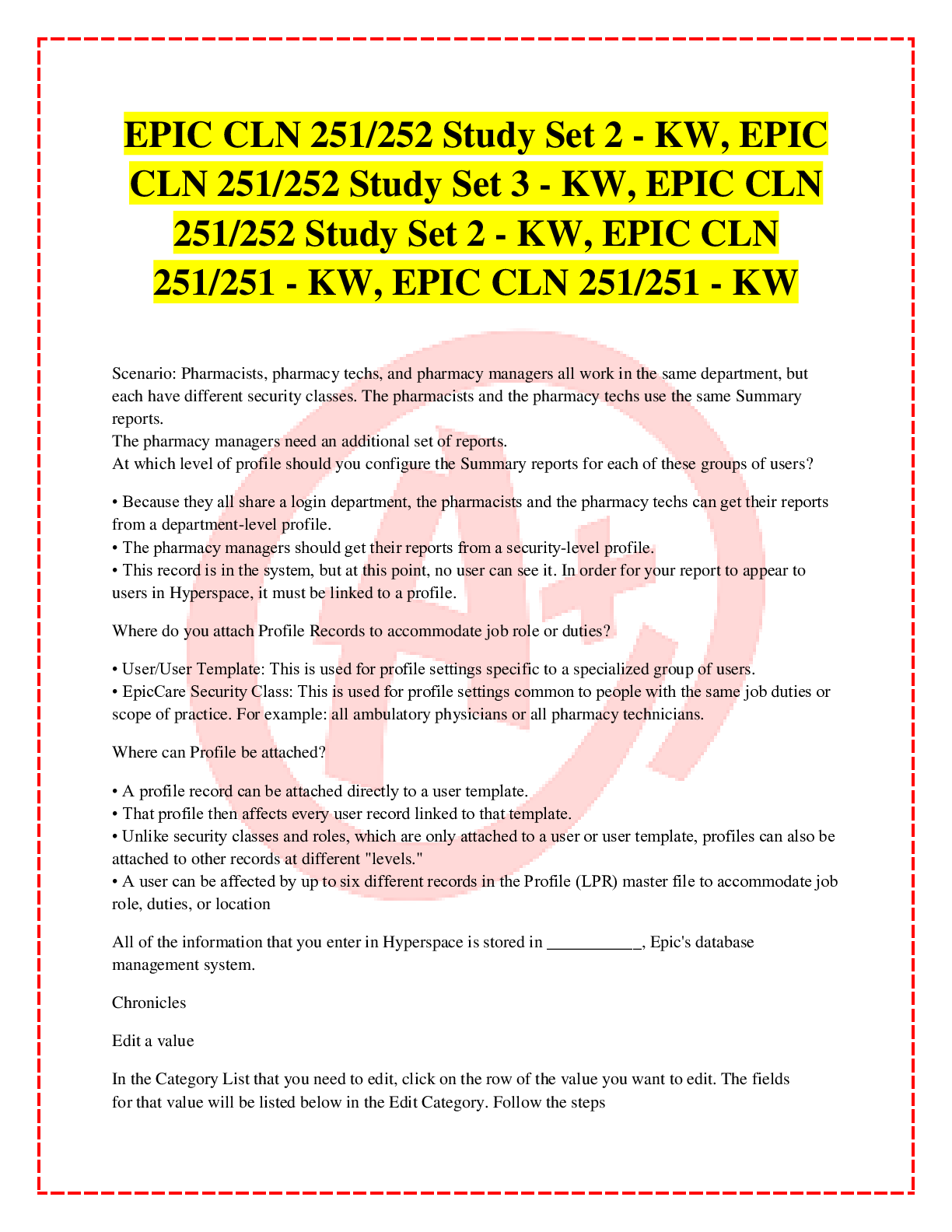Adams, Pharmacology for Nurses: A Pathophysiologic Approach, 5/E Chapter 4
Document Content and Description Below
Adams, Pharmacology for Nurses: A Pathophysiologic Approach, 5/E Chapter 4 Adams, Pharmacology for Nurses: A Pathophysiologic Approach, 5/E Chapter 4 Question 1 Type: MCSA The nurse is conducti... ng medication education for patients with hypertension. The focus of the education is on enhancing the absorption of their medications. The nurse determines that learning has occurred when the patients make which statement? 1. "We can safely take the drug for at least 6 months beyond the expiration date." 2. "We don't need to worry about storage of the drug, it won't lose potency." 3. "We should not take our medications with milk or dairy products." 4. "We need to be careful about taking the medication with certain foods." Correct Answer: 4 Rationale 1: Patients should be taught to avoid taking medications beyond the expiration date. Rationale 2: Storage can affect the medication's strength and may affect how it responds in the body. Rationale 3: There are many more foods that will alter the absorption of medications other than milk and dairy products. Rationale 4: Food can alter the absorption of many medications. Global Rationale: Food can alter the absorption of many medications. Storage can affect the medication's strength and may affect how it responds in the body. There are many more foods that will alter the absorption of medications other than milk and dairy products. Patients should be taught to avoid taking medications beyond the expiration date. Cognitive Level: Analyzing Client Need: Physiological Integrity Client Need Sub: Pharmacological and Parenteral Therapies QSEN Competencies: III.A.1 Demonstrate knowledge of basic scientific methods and processes. AACN Essentials Competencies: 111.1 Explain the interrelationships among theory, practice, and research. NLN Competencies: Knowledge and Science: Integration of knowledge from nursing and other disciplines. Nursing/Integrated Concepts: Nursing Process: Evaluation Learning Outcome: 4.4 Discuss factors affecting drug absorption. MNL Learning Outcome 1.1.3 Relate processes of pharmacokinetics and pharmacodynamics to the therapeutic effect(s) of a drug. Page Number: 41 Question 2Type: MCSA The physician ordered a loading dose of medication for the patient; it is to be followed by a lower dose. When the patient receives the lower dose, she says to the nurse, "I think my doctor made a mistake; my medication dose is too low." What is the best response by the nurse? 1. "The initial dose shortened the half-life, so the medication would work more quickly." 2. "We always give medications this way; the doctor did not make a mistake." 3. "You had a larger dose initially so that the medication would work more quickly." 4. "Giving a larger dose initially will reduce the chance of side effects." Correct Answer: 3 Rationale 1: Loading doses do not shorten the half-life of a drug. Rationale 2: Not all medications are initiated with a loading dose. Rationale 3: Loading doses of medications are used to quickly induce a therapeutic response. Rationale 4: Loading doses do not reduce the occurrence of side effects. Global Rationale: Loading doses of medications are used to quickly induce a therapeutic response. Loading doses do not shorten the half-life of a drug. Not all medications are initiated with a loading dose. Loading doses do not reduce the occurrence of side effects. Cognitive Level: Applying Client Need: Physiological Integrity Client Need Sub: Pharmacological and Parenteral Therapies QSEN Competencies: III.A.1 Demonstrate knowledge of basic scientific methods and processes. AACN Essentials Competencies: 111.1 Explain the interrelationships among theory, practice, and research. NLN Competencies: Knowledge and Science: Integration of knowledge from nursing and other disciplines. Nursing/Integrated Concepts: Nursing Process: Implementation Learning Outcome: 4-12 Differentiate between loading and maintenance doses. MNL Learning Outcome 1.1.3 Relate processes of pharmacokinetics and pharmacodynamics to the therapeutic effect(s) of a drug. Page Number: 47 Question 3 Type: MCSA The patient has meningitis. The physician initially prescribed a water-soluble drug. Another physician changed the order to a lipid-soluble drug. The patient is confused about this. Which plan best resolves the patient's concern? 1. Teach the patient that lipid-soluble drugs are better because of protein binding.2. Teach the patient that lipid-soluble drugs are more effective in treating his illness. 3. Teach the patient that lipid-soluble drugs are better because they have fewer side effects. 4. Teach the patient that lipid-soluble drugs are more effective because they are excreted at a slower rate. Correct Answer: 2 Rationale 1: Not all lipid-soluble drugs are protein bound. Rationale 2: Drug molecules that are lipid soluble will usually pass through plasma membranes by simple diffusion and more easily reach their target cells. Rationale 3: Lipid-soluble drugs do not necessarily have fewer side effects. Not all lipid-soluble drugs are protein bound. Rationale 4: Lipid solubility does not affect drug excretion. Global Rationale: Drug molecules that are lipid soluble will usually pass through plasma membranes by simple diffusion and more easily reach their target cells. Lipid-soluble drugs do not necessarily have fewer side effects. Not all lipid-soluble drugs are protein bound. Lipid solubility does not affect drug excretion. Cognitive Level: Applying Client Need: Physiological Integrity Client Need Sub: Pharmacological and Parenteral Therapies QSEN Competencies: III.A.1 Demonstrate knowledge of basic scientific methods and processes. AACN Essentials Competencies: 111.1 Explain the interrelationships among theory, practice, and research. NLN Competencies: Knowledge and Science: Integration of knowledge from nursing and other disciplines. Nursing/Integrated Concepts: Nursing Process: Planning Learning Outcome: 4-6 Discuss factors affecting drug absorption. MNL Learning Outcome 1.1.3 Relate processes of pharmacokinetics and pharmacodynamics to the therapeutic effect(s) of a drug. Page Number: 41 Question 4 Type: MCSA The patient is malnourished and has a low serum albumin. The physician has ordered aspirin, a highly proteinbound drug, for the patient. Which evaluation by the nurse best describes the effect this will have on the patient? 1. The patient will be at risk to experience a decreased effectiveness of the drug. 2. The patient will be at risk to experience toxic effects of the drug. 3. The patient's kidneys will excrete the drug at a faster rate. 4. The patient's serum globulin is more important than serum albumin.Correct Answer: 2 Rationale 1: Effects from the drug will not be decreased because there is less protein for aspirin to bind with and more free drug available. Rationale 2: Aspirin is a protein-bound drug. With a low albumin, there is less protein for aspirin to bind with, making more free drug available. There may be toxic effects from the drug because there is less protein for aspirin to bind with and more free drug available. Rationale 3: The kidney will not be able to balance the amount of the drug and excrete it at a faster rate. Rationale 4: Serum albumin plays a major role, more than serum globulin. Global Rationale: Aspirin is a protein-bound drug. With a low albumin, there is less protein for aspirin to bind with, making more free drug available. There may be toxic, not decreased, effects from the drug because there is less protein for aspirin to bind with and more free drug available. The kidney will not be able to balance the amount of the drug and excrete it at a faster rate. Serum albumin plays a major role, more than serum globulin. Cognitive Level: Analyzing Client Need: Physiological Integrity Client Need Sub: Pharmacological and Parenteral Therapies QSEN Competencies: III.A.1 Demonstrate knowledge of basic scientific methods and processes. AACN Essentials Competencies: 111.1 Explain the interrelationships among theory, practice, and research. NLN Competencies: Knowledge and Science: Integration of knowledge from nursing and other disciplines. Nursing/Integrated Concepts: Nursing Process: Evaluation Learning Outcome: 4-7 Describe how plasma proteins affect drug distribution. MNL Learning Outcome 1.1.3 Relate processes of pharmacokinetics and pharmacodynamics to the therapeutic effect(s) of a drug. Page Number: 41 Question 5 Type: MCSA The patient is admitted to the hospital in chronic renal failure and is on several medications. What best describes the nurse's assessment of this patient? 1. The patient's liver may compensate for renal failure; the drugs may be effective. 2. The patient may have drug toxicity from all the drugs. 3. The patient may have drug toxicity only if the drugs are excreted by the kidneys. 4. The patient may have decreased effectiveness of the drugs. Correct Answer: 2 Rationale 1: The liver cannot compensate for renal failure; the patient is at risk for drug toxicity.Rationale 2: Since the kidneys are the primary route of excretion for many drugs, chronic renal failure puts the patient at risk for drug toxicity. Rationale 3: The patient in chronic renal failure will more likely have drug toxicity than decreased effectiveness of the drugs. Rationale 4: Since the majority of drugs are excreted by the kidneys, the patient will most likely have drug toxicity. Global Rationale: Since the kidneys are the primary route of excretion for many drugs, chronic renal failure puts the patient at risk for drug toxicity. The patient in chronic renal failure will more likely have drug toxicity than decreased effectiveness of the drugs. The liver cannot compensate for renal failure; the patient is at risk for drug toxicity. Since the majority of drugs are excreted by the kidneys, the patient will most likely have drug toxicity. Cognitive Level: Applying Client Need: Physiological Integrity Client Need Sub: Pharmacological and Parenteral Therapies QSEN Competencies: III.A.1 Demonstrate knowledge of basic scientific methods and processes. AACN Essentials Competencies: 111.1 Explain the interrelationships among theory, practice, and research. NLN Competencies: Knowledge and Science: Integration of knowledge from nursing and other disciplines. Nursing/Integrated Concepts: Nursing Process: Assessment Learning Outcome: 4-8 Identify major processes by which drugs are excreted. MNL Learning Outcome 1.1.3 Relate processes of pharmacokinetics and pharmacodynamics to the therapeutic effect(s) of a drug. Page Number: 44 Question 6 Type: MCSA The patient comes to the emergency department following an overdose of aspirin, an acidic drug. What will the best plan of the nurse include? 1. Administration of intravenous fluids to flush the kidneys 2. Administration of ammonium chloride to the patient 3. Administration of sodium bicarbonate to the patient 4. Administration of intravenous proteins to bind the aspirin Correct Answer: 3 Rationale 1: Administering intravenous (IV) fluids will not increase the excretion of aspirin from the body. Rationale 2: Ammonium chloride will acidify the urine and cause reabsorption of the aspirin. Rationale 3: Sodium bicarbonate will alkalinize the urine and increase the excretion of aspirin from the body. Rationale 4: Administering proteins will not help with the excretion of aspirin from the body.Global Rationale: : Sodium bicarbonate will alkalinize the urine and increase the excretion of aspirin from the body. Administering intravenous (IV) fluids will not increase the excretion of aspirin from the body. Ammonium chloride will acidify the urine and cause reabsorption of the aspirin. Administering proteins will not help with the excretion of aspirin from the body. Cognitive Level: Applying Client Need: Physiological Integrity Client Need Sub: Pharmacological and Parenteral Therapies QSEN Competencies: III.A.1 Demonstrate knowledge of basic scientific methods and processes. AACN Essentials Competencies: 111.1 Explain the interrelationships among theory, practice, and research. NLN Competencies: Knowledge and Science: Integration of knowledge from nursing and other disciplines. Nursing/Integrated Concepts: Nursing Process: Planning Learning Outcome: 4-8 Identify major processes by which drugs are excreted. MNL Learning Outcome 1.1.3 Relate processes of pharmacokinetics and pharmacodynamics to the therapeutic effect(s) of a drug. Page Number: 44 Question 7 Type: MCSA The patient is complaining of a severe headache. The physician orders aspirin. Which action by the nurse will result in the fastest relief of the patient's headache? 1. Administer the aspirin with an alkaline food, like cottage cheese. 2. Administer the aspirin in an enteric-coated formulation. 3. Administer the aspirin with a high-fat food, like peanut butter. 4. Administer the aspirin on an empty stomach. Correct Answer: 4 Rationale 1: Cottage cheese will slow absorption and increase the time for the drug's effect. Rationale 2: Administering the aspirin in an enteric-coated formulation will lessen gastrointestinal irritation, but will increase the time for the drug's effect. Rationale 3: Peanut butter will slow absorption and increase the time for the drug's effect. Rationale 4: Acids such as aspirin are best absorbed in the acidic environment of the stomach, so the aspirin should be administered on an empty stomach. Global Rationale: Acids such as aspirin are best absorbed in the acidic environment of the stomach, so the aspirin should be administered on an empty stomach. Administering the aspirin in an enteric-coated formulation will lessen gastrointestinal irritation, but will increase the time for the drug's effect. Peanut butter and cottage cheese will slow absorption and increase the time for the drug's effect.Cognitive Level: Applying Client Need: Physiological Integrity Client Need Sub: Pharmacological and Parenteral Therapies QSEN Competencies: III.A.1 Demonstrate knowledge of basic scientific methods and processes. AACN Essentials Competencies: 111.1 Explain the interrelationships among theory, practice, and research. NLN Competencies: Knowledge and Science: Integration of knowledge from nursing and other disciplines. Nursing/Integrated Concepts: Nursing Process: Evaluation Learning Outcome: 4-4 Discuss factors affecting drug absorption. MNL Learning Outcome 1.1.3 Relate processes of pharmacokinetics and pharmacodynamics to the therapeutic effect(s) of a drug. Page Number: 41 Question 8 Type: MCSA The patient is receiving lithium (Eskalith) and asks the nurse why he has to have blood drawn so often. What is the best response by the nurse? 1. "To detect side effects before they become a problem." 2. "To be sure the medication is working properly." 3. "To determine if your body is responding as it should." 4. "To be sure you have the correct amount of medication in your system." Correct Answer: 4 Rationale 1: Side effects are best determined by patient assessment. Rationale 2: A lab test will not confirm that the medication is working properly; assessment of the patient confirms this. Rationale 3: Body response to the medication is best determined by patient assessment. Rationale 4: Medications, such as lithium (Eskalith), with a narrow therapeutic range must be monitored with lab tests; this is how the correct dosage is determined. Global Rationale: Medications, such as lithium (Eskalith), with a narrow therapeutic range must be monitored with lab tests; this is how the correct dosage is determined. A lab test will not confirm that the medication is working properly; assessment of the patient confirms this. Body response to the medication is best determined by patient assessment. Side effects are best determined by patient assessment. Cognitive Level: Applying Client Need: Physiological Integrity Client Need Sub: Pharmacological and Parenteral Therapies QSEN Competencies: III.A.1 Demonstrate knowledge of basic scientific methods and processes. AACN Essentials Competencies: 111.1 Explain the interrelationships among theory, practice, and research.NLN Competencies: Knowledge and Science: Integration of knowledge from nursing and other disciplines. Nursing/Integrated Concepts: Nursing Process: Implementation Learning Outcome: 4-11 Explain how a drug reaches and maintains its therapeutic range in the plasma. MNL Learning Outcome 1.1.3 Relate processes of pharmacokinetics and pharmacodynamics to the therapeutic effect(s) of a drug. Page Number: 45 Question 9 Type: MCSA The nursing mother asks the nurse if it is all right to take St. John's wort for mild depression. What is the best response by the nurse? 1. "No, it will probably cause your baby to have more allergies." 2. "No, because it might decrease the amount of milk you produce." 3. "No, it could be excreted in your milk and affect the baby." 4. "No, it will affect the taste of your milk, and your baby might reject nursing." Correct Answer: 3 Rationale 1: Taking St. John's wort is not likely to cause the baby to have more allergies. Rationale 2: Taking St. John's wort is not likely to decrease the amount of milk the mother produces. Rationale 3: Many drugs are excreted in breast milk and can affect the nursing infant. Rationale 4: Taking St. John's wort may affect the taste of the mother's milk, but this is not the most important response. Global Rationale: Many drugs are excreted in breast milk and can affect the nursing infant. Taking St. John's wort is not likely to cause the baby to have more allergies. Taking St. John's wort is not likely to decrease the amount of milk the mother produces. Taking St. John's wort may affect the taste of the mother's milk, but this is not the most important response. Cognitive Level: Applying Client Need: Physiological Integrity Client Need Sub: Pharmacological and Parenteral Therapies QSEN Competencies: III.A.1 Demonstrate knowledge of basic scientific methods and processes. AACN Essentials Competencies: 111.1 Explain the interrelationships among theory, practice, and research. NLN Competencies: Knowledge and Science: Integration of knowledge from nursing and other disciplines. Nursing/Integrated Concepts: Nursing Process: Implementation Learning Outcome: 4-8 Identify major processes by which drugs are excreted. MNL Learning Outcome 1.1.3 Relate processes of pharmacokinetics and pharmacodynamics to the therapeutic effect(s) of a drug. Page Number: 44Question 10 Type: MCMA The nursing instructor is teaching pharmacology to student nurses. What will the nursing instructor include as the four major components of pharmacokinetics? Note: Credit will be given only if all correct choices and no incorrect choices are selected. Standard Text: Select all that apply. 1. How drugs move from the site of administration to circulating fluids 2. How drugs are converted to a form that is easily removed from the body 3. How drugs change body illnesses and pathogens 4. How drugs are transported throughout the body 5. How drugs are removed from the body Correct Answer: 1,2,4,5 Rationale 1: Absorption describes how drugs move from the site of administration to circulating fluids. Rationale 2: Metabolism describes how drugs are converted to a form that is easily removed from the body. Rationale 3: Pharmacodynamics describes how drugs change body illnesses and pathogens. Rationale 4: Distribution describes how drugs are transported throughout the body. Rationale 5: Excretion describes how drugs are removed from the body. Global Rationale: Absorption describes how drugs move from the site of administration to circulating fluids. Distribution describes how drugs are transported throughout the body. Metabolism describes how drugs are converted to a form that is easily removed from the body. Excretion describes how drugs are removed from the body. Pharmacodynamics describes how drugs change body illnesses and pathogens. Cognitive Level: Applying Client Need: Physiological Integrity Client Need Sub: Pharmacological and Parenteral Therapies QSEN Competencies: III.A.1 Demonstrate knowledge of basic scientific methods and processes. AACN Essentials Competencies: 111.1 Explain the interrelationships among theory, practice, and research. NLN Competencies: Knowledge and Science: Integration of knowledge from nursing and other disciplines. Nursing/Integrated Concepts: Nursing Process: Implementation Learning Outcome: 4-2 Identify the four components of pharmacokinetics. MNL Learning Outcome 1.1.3 Relate processes of pharmacokinetics and pharmacodynamics to the therapeutic effect(s) of a drug.Page Number: 39 Question 11 Type: MCSA The patient is scheduled to receive a medication that is an enzyme inducer of the P450 system. What best describes the effect of this medication on the patient? 1. In time, the patient will experience no effect from other medications. 2. In time, the patient will experience increased effects from other medications. 3. In time, the patient will experience a reduced effect from this medication. 4. In time, the patient will experience an increased effect from this medication. Correct Answer: 3 Rationale 1: The patient will experience a reduced effect from other medications, not an absence of effect. Rationale 2: An enzyme inhibitor will result in an increased effect from other medications. Rationale 3: An enzyme inducer will increase the rate of its own metabolism, thereby reducing its effectiveness. Rationale 4: An enzyme inhibitor will result in an increased effect of this medication. Global Rationale: An enzyme inducer will increase the rate of its own metabolism, thereby reducing its effectiveness. An enzyme inhibitor will result in an increased effect of this medication. An enzyme inhibitor will result in an increased effect from other medications. The patient will experience a reduced effect from other medications, not an absence of effect. Cognitive Level: Analyzing Client Need: Physiological Integrity Client Need Sub: Pharmacological and Parenteral Therapies QSEN Competencies: III.A.1 Demonstrate knowledge of basic scientific methods and processes. AACN Essentials Competencies: 111.1 Explain the interrelationships among theory, practice, and research. NLN Competencies: Knowledge and Science: Integration of knowledge from nursing and other disciplines. Nursing/Integrated Concepts: Nursing Process: Evaluation Learning Outcome: 4-5 Explain the metabolism of drugs and its applications to pharmacotherapy. MNL Learning Outcome 1.1.3 Relate processes of pharmacokinetics and pharmacodynamics to the therapeutic effect(s) of a drug. Page Number: 43 Question 12 Type: MCMA The patient tells the nurse that he is on many medications and questions how they all get to the right places. What are the best responses by the nurse?Note: Credit will be given only if all correct choices and no incorrect choices are selected. Standard Text: Select all that apply. 1. "It depends on how much protein you have in your body." 2. "It depends on the health of your kidneys." 3. "It depends on whether they are fat based or water based." 4. "It depends on the amount of blood flow to your body tissues." 5. "It depends on the health of your liver." Correct Answer: 1,3,4 Rationale 1: Distribution of drugs depends on protein binding. Rationale 2: The health of the kidneys refers to excretion, not distribution. Rationale 3: Distribution of drugs depends on the lipid solubility of the drug. Rationale 4: Distribution of drugs depends on the amount of blood flow to body tissues. Rationale 5: The health of the liver refers to metabolism, not distribution. Global Rationale: Distribution of drugs depends on the amount of blood flow to body tissues, the lipid solubility of the drug, and protein binding. The health of the liver refers to metabolism, not distribution. The health of the kidneys refers to excretion, not distribution. Cognitive Level: Evaluating Client Need: Physiological Integrity Client Need Sub: Pharmacological and Parenteral Therapies QSEN Competencies: III.A.1 Demonstrate knowledge of basic scientific methods and processes. AACN Essentials Competencies: 111.1 Explain the interrelationships among theory, practice, and research. NLN Competencies: Knowledge and Science: Integration of knowledge from nursing and other disciplines. Nursing/Integrated Concepts: Nursing Process: Implementation Learning Outcome: 4-6 Discuss how drugs are distributed throughout the body. MNL Learning Outcome 1.1.3 Relate processes of pharmacokinetics and pharmacodynamics to the therapeutic effect(s) of a drug. Page Number: 41 Question 13 Type: MCSA The patient receives a drug that is excreted in the bile. What will the best nursing assessment of the effect of this drug on the patient include?1. The effect of the drug will be a prolonged action. 2. The effect of the drug will be increased side effects. 3. The effect of the drug will be decreased side effects. 4. The effect of the drug will be decreased. Correct Answer: 1 Rationale 1: Most bile is circulated back to the liver so drugs secreted into the bile will be recirculated numerous times with the bile, resulting in a prolonged action of the drug. Rationale 2: Side effects may or may not be increased; this is dose dependent. Rationale 3: Bile-excreted drugs do not have decreased side effects. Rationale 4: Bile-excreted drugs do not have a decreased effect. Global Rationale: Most bile is circulated back to the liver so drugs secreted into the bile will be recirculated numerous times with the bile, resulting in a prolonged action of the drug. Bile-excreted drugs do not have a decreased effect, nor are side effects decreased. Side effects may or may not be increased; this is dose dependent. Cognitive Level: Applying Client Need: Physiological Integrity Client Need Sub: Pharmacological and Parenteral Therapies QSEN Competencies: III.A.1 Demonstrate knowledge of basic scientific methods and processes. AACN Essentials Competencies: 111.1 Explain the interrelationships among theory, practice, and research. NLN Competencies: Knowledge and Science: Integration of knowledge from nursing and other disciplines. Nursing/Integrated Concepts: Nursing Process: Assessment Learning Outcome: 4-9 Explain how enterohepatic recirculation might affect drug activity. MNL Learning Outcome 1.1.3 Relate processes of pharmacokinetics and pharmacodynamics to the therapeutic effect(s) of a drug. Page Number: 44 Question 14 Type: MCSA The nurse administers medications by various routes of delivery. The nurse recognizes which route of administration as requiring higher dosages of drugs to achieve a therapeutic effect? 1. Intravenous route 2. Oral route 3. Rectal route 4. Sublingual routeCorrect Answer: 2 Rationale 1: Intravenously administered drugs are not affected by the "first-pass effect." Rationale 2: Oral medications pass into the hepatoportal circulation and may be completely metabolized before reaching the general circulation. This so-called "first pass effect" may necessitate the use of higher dosages of oral medications to achieve a therapeutic effect. Rationale 3: Rectally administered drugs are not affected by the "first-pass effect." Rationale 4: Sublingually administered drugs are not affected by the "first-pass effect." Global Rationale: Oral medications pass into the hepatoportal circulation and may be completely metabolized before reaching the general circulation. This so-called "first pass effect" may necessitate the use of higher dosages of oral medications to achieve a therapeutic effect. None of the other routes, sublingual, rectal, or intravenous, are affected by the "first-pass effect." Cognitive Level: Applying Client Need: Physiological Integrity Client Need Sub: Pharmacological and Parenteral Therapies QSEN Competencies: III.A.1 Demonstrate knowledge of basic scientific methods and processes. AACN Essentials Competencies: 111.1 Explain the interrelationships among theory, practice, and research. NLN Competencies: Knowledge and Science: Integration of knowledge from nursing and other disciplines. Nursing/Integrated Concepts: Nursing Process: Planning Learning Outcome: 4-5 Explain the metabolism of drugs and its applications to pharmacotherapy. MNL Learning Outcome 1.1.3 Relate processes of pharmacokinetics and pharmacodynamics to the therapeutic effect(s) of a drug. Page Number: 43 Question 15 Type: MCSA Enzymatic activity that changes a medication into a less active form is an example of 1. pharmacodynamics. 2. active transport. 3. pharmacokinetics. 4. diffusion. Correct Answer: 3 Rationale 1: Pharmacodynamics involves how drugs change the body. Rationale 2: Active transport is the movement of a chemical against concentration or gradient. Rationale 3: Pharmacokinetics describes how drugs are handled within the body.Rationale 4: Diffusion is the movement of a chemical from an area of higher concentration to an area of lower concentration. Global Rationale: Pharmacokinetics describes how drugs are handled within the body. Pharmacodynamics involves how drugs change the body. Diffusion is the movement of a chemical from an area of higher concentration to an area of lower concentration. Active transport is the movement of a chemical against concentration or gradient. Cognitive Level: Understanding Client Need: Physiological Integrity Client Need Sub: Pharmacological and Parenteral Therapies QSEN Competencies: III.A.1 Demonstrate knowledge of basic scientific methods and processes. AACN Essentials Competencies: 111.1 Explain the interrelationships among theory, practice, and research. NLN Competencies: Knowledge and Science: Integration of knowledge from nursing and other disciplines. Nursing/Integrated Concepts: Nursing Process: Assessment Learning Outcome: 4-1 Explain the applications of pharmacokinetics to clinical practice. MNL Learning Outcome 1.1.3 Relate processes of pharmacokinetics and pharmacodynamics to the therapeutic effect(s) of a drug. Page Number: 39 Question 16 Type: MCSA Which of the following are the four categories of pharmacokinetics? 1. Diffusion, active transport, interspersing, and storage 2. Ingestion, metabolism, interspersing, and excretion 3. Absorption, distribution, metabolism, and excretion 4. Ingestion, settling, movement, and storage Correct Answer: 3 Rationale 1: Diffusion, active transport, interspersing, and storage are not the four categories of pharmacokinetics. Rationale 2: Ingestion, metabolism, interspersing, and excretion are not the four categories of pharmacokinetics. Rationale 3: The four categories of pharmacokinetics are absorption, distribution, metabolism, and excretion. Rationale 4: Ingestion, settling, movement, and storage are not the four categories of pharmacokinetics. Global Rationale: The four categories of pharmacokinetics are absorption, distribution, metabolism, and excretion. Cognitive Level: Remembering Client Need: Physiological IntegrityClient Need Sub: Pharmacological and Parenteral Therapies QSEN Competencies: III.A.1 Demonstrate knowledge of basic scientific methods and processes. AACN Essentials Competencies: 111.1 Explain the interrelationships among theory, practice, and research. NLN Competencies: Knowledge and Science: Integration of knowledge from nursing and other disciplines. Nursing/Integrated Concepts: Nursing Process: Assessment Learning Outcome: 4-2 Identify the four components of pharmacokinetics. MNL Learning Outcome 1.1.3 Relate processes of pharmacokinetics and pharmacodynamics to the therapeutic effect(s) of a drug. Page Number: 39 Question 17 Type: MCSA Following ingestion, a drug crosses a membrane from an area of higher concentration to an area of lower concentration. This is an example of 1. active transport. 2. osmosis. 3. diffusion. 4. metabolism. Correct Answer: 3 Rationale 1: Active transport is the movement of a chemical against concentration or gradient. Rationale 2: Osmosis involves the movement of water. Rationale 3: Diffusion is the movement of a chemical from an area of higher concentration to an area of lower concentration. Rationale 4: Metabolism involves chemical conversion. Global Rationale: Diffusion is the movement of a chemical from an area of higher concentration to an area of lower concentration. Active transport is the movement of a chemical against concentration or gradient. Osmosis involves the movement of water, and metabolism involves chemical conversion. Cognitive Level: Understanding Client Need: Physiological Integrity Client Need Sub: Pharmacological and Parenteral Therapies QSEN Competencies: III.A.1 Demonstrate knowledge of basic scientific methods and processes. AACN Essentials Competencies: 111.1 Explain the interrelationships among theory, practice, and research. NLN Competencies: Knowledge and Science: Integration of knowledge from nursing and other disciplines. Nursing/Integrated Concepts: Nursing Process: Assessment Learning Outcome: 4-3 Explain how substances travel across plasma membranes.MNL Learning Outcome 1.1.3 Relate processes of pharmacokinetics and pharmacodynamics to the therapeutic effect(s) of a drug. Page Number: 39 Question 18 Type: MCSA Aspirin is ionized as it enters the small intestine. Which statement is accurate regarding the absorption of aspirin in the small intestine? 1. Absorption is decreased. 2. Absorption is increased. 3. Ionization has nothing to do with the absorption rate. 4. Aspirin must travel past the small intestine for absorption to occur. Correct Answer: 1 Rationale 1: The small intestine is a more alkaline environment. Aspirin is an acidic drug that is ionized in the small intestine and will have lower absorption rates. Rationale 2: Higher rates of absorption occur in the stomach (an acidic environment). Rationale 3: Ionization state affects absorption rate. Rationale 4: Absorption of aspirin occurs in the stomach. Global Rationale: The small intestine is a more alkaline environment, which facilitates the absorption of basic drugs. Aspirin is an acidic drug that is ionized in the small intestine and will have lower absorption rates. Higher rates of absorption occur in the stomach (an acidic environment). Absorption of aspirin occurs in the stomach. Cognitive Level: Understanding Client Need: Physiological Integrity Client Need Sub: Pharmacological and Parenteral Therapies QSEN Competencies: III.A.1 Demonstrate knowledge of basic scientific methods and processes. AACN Essentials Competencies: 111.1 Explain the interrelationships among theory, practice, and research. NLN Competencies: Knowledge and Science: Integration of knowledge from nursing and other disciplines. Nursing/Integrated Concepts: Nursing Process: Assessment Learning Outcome: 4-4 Discuss factors affecting drug absorption. MNL Learning Outcome 1.1.3 Relate processes of pharmacokinetics and pharmacodynamics to the therapeutic effect(s) of a drug. Page Number: 41 Question 19 Type: MCSAWhich statement regarding medication distribution within the body is accurate? 1. The blood–brain barrier inhibits rapid crossing of all medications. 2. Body organs with high levels of blood flow are more difficult organs to which to deliver drugs. 3. Medications that are lipid-soluble are more completely distributed. 4. Drug–protein complexes must form prior to crossing capillary membranes. Correct Answer: 3 Rationale 1: Some medications (sedatives) are able to rapidly cross the blood–brain barrier. Rationale 2: Body organs with low levels of blood flow are more difficult organs to which to deliver drugs. Rationale 3: Lipid-soluble medications are absorbed and distributed quicker and more quickly than those that are not. Rationale 4: When medications bind to proteins, their size increases, preventing them from passing through capillary membranes. Global Rationale: Lipid-soluble medications are absorbed and distributed quicker and more quickly than those that are not. Body organs with low levels of blood flow are more difficult organs to which to deliver drugs. When medications bind to proteins, their size increases, preventing them from passing through capillary membranes. Some medications (sedatives) are able to rapidly cross the blood–brain barrier. Cognitive Level: Understanding Client Need: Physiological Integrity Client Need Sub: Pharmacological and Parenteral Therapies QSEN Competencies: III.A.1 Demonstrate knowledge of basic scientific methods and processes. AACN Essentials Competencies: 111.1 Explain the interrelationships among theory, practice, and research. NLN Competencies: Knowledge and Science: Integration of knowledge from nursing and other disciplines. Nursing/Integrated Concepts: Nursing Process: Assessment Learning Outcome: 4-6 Discuss how drugs are distributed throughout the body. MNL Learning Outcome 1.1.3 Relate processes of pharmacokinetics and pharmacodynamics to the therapeutic effect(s) of a drug. Page Number: 41–42 Question 20 Type: MCSA Which organ is the most responsible for the first-pass effect? 1. Bladder 2. Kidneys3. Liver 4. Stomach Correct Answer: 3 Rationale 1: The bladder is not the organ most responsible for the first-pass effect. Rationale 2: The kidneys are not the organs most responsible for the first-pass effect. Rationale 3: The first pass effect occurs in the liver. Rationale 4: The stomach is not the organ most responsible for the first-pass effect. Global Rationale: The first pass effect occurs in the liver. Cognitive Level: Remembering Client Need: Physiological Integrity Client Need Sub: Pharmacological and Parenteral Therapies QSEN Competencies: III.A.1 Demonstrate knowledge of basic scientific methods and processes. AACN Essentials Competencies: 111.1 Explain the interrelationships among theory, practice, and research. NLN Competencies: Knowledge and Science: Integration of knowledge from nursing and other disciplines. Nursing/Integrated Concepts: Nursing Process: Assessment Learning Outcome: 4-5 Explain the metabolism of drugs and its applications to pharmacotherapy. MNL Learning Outcome 1.1.3 Relate processes of pharmacokinetics and pharmacodynamics to the therapeutic effect(s) of a drug. Page Number: 43 Question 21 Type: MCSA Which substance has the lowest rate of crossing renal tubular membranes and would therefore be excreted in the urine? 1. Lipid-soluble drugs 2. Volatile drugs 3. Ionized drugs 4. Non-ionized drugs Correct Answer: 3 Rationale 1: Lipid-soluble drugs cross renal tubular membranes easily and return to the circulation.Rationale 2: Volatile drugs are eliminated through respiration. Rationale 3: Ionized and water-soluble drugs are less likely to cross renal tubular walls and will therefore be excreted. Rationale 4: Non-ionized drugs cross the renal tubular membranes easily and return to circulation. Global Rationale: Ionized and water-soluble drugs are less likely to cross renal tubular walls and will therefore be excreted. Non-ionized and lipid-soluble drugs cross renal tubular membranes easily and return to the circulation. Volatile drugs are eliminated through respiration. Cognitive Level: Remembering Client Need: Physiological Integrity Client Need Sub: Pharmacological and Parenteral Therapies QSEN Competencies: III.A.1 Demonstrate knowledge of basic scientific methods and processes. AACN Essentials Competencies: 111.1 Explain the interrelationships among theory, practice, and research. NLN Competencies: Knowledge and Science: Integration of knowledge from nursing and other disciplines. Nursing/Integrated Concepts: Nursing Process: Evaluation Learning Outcome: 4-8 Identify major processes by which drugs are excreted. MNL Learning Outcome 1.1.3 Relate processes of pharmacokinetics and pharmacodynamics to the therapeutic effect(s) of a drug. Page Number: 44 Question 22 Type: MCSA Which statement is accurate regarding medications that end up being secreted in bile? 1. All medications secreted in bile are excreted in the feces. 2. Some medications are excreted in the feces while others can be recirculated to the liver many times. 3. Most medications secreted in bile are metabolized in the gallbladder. 4. Generally, medications are not secreted in the bile. Correct Answer: 2 Rationale 1: Some bile (and medications within) is excreted in the feces. Rationale 2: Most bile is circulated back to the liver by enterohepatic circulation, where medications are metabolized in the liver. Rationale 3: Medications are not metabolized in the gallbladder. Rationale 4: Some medications are secreted in bile.Global Rationale: Most bile is circulated back to the liver by enterohepatic circulation, where medications are metabolized in the liver. Some bile (and medications within) is excreted in the feces. Medications are not metabolized in the gallbladder. Cognitive Level: Understanding Client Need: Physiological Integrity Client Need Sub: Pharmacological and Parenteral Therapies QSEN Competencies: III.A.1 Demonstrate knowledge of basic scientific methods and processes. AACN Essentials Competencies: 111.1 Explain the interrelationships among theory, practice, and research. NLN Competencies: Knowledge and Science: Integration of knowledge from nursing and other disciplines. Nursing/Integrated Concepts: Nursing Process: Planning Learning Outcome: 4-9 Explain how enterohepatic recirculation might affect drug activity. MNL Learning Outcome 1.1.3 Relate processes of pharmacokinetics and pharmacodynamics to the therapeutic effect(s) of a drug. Page Number: 44 Question 23 Type: MCSA Which finding would most accurately indicate that a therapeutic range for a medication had been reached? 1. No serious adverse effects are experienced following administration. 2. The indication for administration was achieved without serious side effects. 3. A pre-specified amount (in milligrams) was administered. 4. The medication was effective, but the patient experienced a lethal dysrhythmia. Correct Answer: 2 Rationale 1: Lack of serious adverse effects does not indication therapeutic range has been reached. Rationale 2: The therapeutic range of a drug is between the minimum effective concentration and the toxic concentration. Rationale 3: Standard doses of medications are determined by expected therapeutic range, not vice versa. Rationale 4: Effective medication is desired, but not at the expense of a lethal dysrhythmia. Global Rationale: The therapeutic range of a drug is between the minimum effective concentration and the toxic concentration. Lack of serious adverse effects does not indicate therapeutic range has been reached. Standard doses of medications are determined by expected therapeutic range, not vice versa. Effective medication is desired, but not at the expense of a lethal dysrhythmia. Cognitive Level: Understanding Client Need: Physiological Integrity Client Need Sub: Pharmacological and Parenteral Therapies QSEN Competencies: III.A.1 Demonstrate knowledge of basic scientific methods and processes.AACN Essentials Competencies: 111.1 Explain the interrelationships among theory, practice, and research. NLN Competencies: Knowledge and Science: Integration of knowledge from nursing and other disciplines. Nursing/Integrated Concepts: Nursing Process: Assessment Learning Outcome: 4-11 Explain how a drug reaches and maintains its therapeutic range in the plasma. MNL Learning Outcome 1.1.3 Relate processes of pharmacokinetics and pharmacodynamics to the therapeutic effect(s) of a drug. Page Number: 45 Question 24 Type: MCMA The nurse is teaching a patient the importance of taking the medication as prescribed. Patient teaching is guided by the nurse's knowledge of which principles of pharmacokinetics? Note: Credit will be given only if all correct choices and no incorrect choices are selected. Standard Text: Select all that apply. 1. A medication taken by injection must cross the membranes of the gastrointestinal tract to get to the bloodstream before it can be distributed throughout the body. 2. A drug may be exposed to several physiological processes while en route to target cells. 3. Liver enzymes may chemically change the drug. 4. Excretion organs such as kidneys and intestines must be healthy enough to eliminate the drug. 5. Many processes to which drugs are exposed are destructive, thereby helping facilitate the drug's movement throughout the body. Correct Answer: 2,3,4,5 Rationale 1: Medications taken by mouth must cross the membranes of the GI tract to get to the bloodstream in order to be distributed throughout the body. This is not the case for medications administered by injection. Rationale 2: Drugs taken orally are often exposed to physiological processes such as stomach acid and digestive enzymes. Rationale 3: Enzymes in the liver may chemically change some drugs. Rationale 4: Drugs will continue to act on the body until they are either metabolized to an inactive form or are excreted. Pathologic states such as kidney disease can increase the drug's action on the body. Rationale 5: Many destructive processes, such as when stomach acid breaks down food, can break down the drug molecule before it can reach the target cells. This will facilitate the drug's movement throughout the body. Global Rationale: Medications taken by mouth must cross the membranes of the GI tract to get to the bloodstream in order to be distributed throughout the body. This is not the case for medications administered byinjection. Drugs taken orally are often exposed to physiological processes such as stomach acid and digestive enzymes. Enzymes in the liver may chemically change some drugs. Drugs will continue to act on the body until they are either metabolized to an inactive form or are excreted. Pathologic states such as kidney disease can increase the drug's action on the body. Many destructive processes, such as when stomach acid breaks down food, can break down the drug molecule before it can reach the target cells. This will facilitate the drug's movement throughout the body. Cognitive Level: Applying Client Need: Physiological Integrity Client Need Sub: Pharmacological and Parenteral Therapies QSEN Competencies: III.A.1 Demonstrate knowledge of basic scientific methods and processes. AACN Essentials Competencies: 111.1 Explain the interrelationships among theory, practice, and research. NLN Competencies: Knowledge and Science: Integration of knowledge from nursing and other disciplines. Nursing/Integrated Concepts: Nursing Process: Implementation Learning Outcome: 4-1 Explain the applications of pharmacokinetics to clinical practice. MNL Learning Outcome 1.1.3 Relate processes of pharmacokinetics and pharmacodynamics to the therapeutic effect(s) of a drug. Page Number: 39 Question 25 Type: MCMA The nurse is reviewing the role of diffusion in the distribution of medications. Drugs that cannot be distributed by simple diffusion include those with which characteristics? Note: Credit will be given only if all correct choices and no incorrect choices are selected. Standard Text: Select all that apply. 1. Large molecules 2. Ionization 3. Water-soluble agents 4. Alcohol 5. Urea Correct Answer: 1,2,3 Rationale 1: Large molecules have difficulty crossing plasma membranes by simple diffusion. Rationale 2: Ionized drugs have difficulty crossing plasma membranes by simple diffusion. These drugs may require carrier, or transport, proteins to cross membranes. Rationale 3: Water-soluble agents have difficulty crossing plasma membranes by simple diffusion.Rationale 4: Diffusion assumes that the chemical is able to freely cross the plasma membrane. Drugs may also enter through open channels in the plasma membrane; however, the molecule must be very small, such as alcohol. Rationale 5: Diffusion assumes that the chemical is able to freely cross the plasma membrane. Drugs may also enter through open channels in the plasma membrane; however, the molecule must be very small, such as urea. Global Rationale: Large molecules have difficulty crossing plasma membranes by simple diffusion. Ionized drugs have difficulty crossing plasma membranes by simple diffusion. These drugs may require carrier, or transport, proteins to cross membranes. Water-soluble agents have difficulty crossing plasma membranes by simple diffusion. Diffusion assumes that the chemical is able to freely cross the plasma membrane. Drugs may also enter through open channels in the plasma membrane; however, the molecule must be very small, such as alcohol or urea. Cognitive Level: Applying Client Need: Physiological Integrity Client Need Sub: Pharmacological and Parenteral Therapies QSEN Competencies: III.A.1 Demonstrate knowledge of basic scientific methods and processes. AACN Essentials Competencies: 111.1 Explain the interrelationships among theory, practice, and research. NLN Competencies: Knowledge and Science: Integration of knowledge from nursing and other disciplines. Nursing/Integrated Concepts: Nursing Process: Assessment Learning Outcome: 4-3 Explain how substances travel across plasma membranes. MNL Learning Outcome 1.1.3 Relate processes of pharmacokinetics and pharmacodynamics to the therapeutic effect(s) of a drug. Page Number: 39 Question 26 Type: MCMA A patient who has received an oral medication for treatment of hives says, “How long will it be before my skin clears and quits itching?” Which concepts should the nurse consider when formulating a response? Note: Credit will be given only if all correct choices and no incorrect choices are selected. Standard Text: Select all that apply. 1. The amount of time between administration and the drug taking effect is known as onset of action. 2. Peak plasma levels rarely occur with oral medications. 3. Duration of action is the amount of time a drug is effective. 4. Peak plasma level is dependent on the drug’s plasma half-life (t1/2). 5. Drugs with short half-lives are ineffective in treating systemic illnesses. Correct answer: 1,3Rationale 1: Onset of drug action represents the amount of time it takes to produce a therapeutic effect after drug administration. Rationale 2: All medications have a peak plasma level. Rationale 3: Duration of drug action is the amount of time a drug maintains its therapeutic effect. Rationale 4: Peak plasma level and plasma half-life (t1/2) are related but not strictly dependent on one another. Rationale 5: The effectiveness of a drug is not dependent on half-life as long as dosing frequency is correct. Global Rationale: Onset of drug action represents the amount of time it takes to produce a therapeutic effect after drug administration. All medications have a peak plasma level. Duration of drug action is the amount of time a drug maintains its therapeutic effect. Peak plasma level and plasma half-life (t1/2) are related but not strictly dependent on one another. The effectiveness of a drug is not dependent on half-life as long as dosing frequency is correct. Cognitive Level: Analyzing Client Need: Physiological Integrity Client Need Sub: Pharmacological and Parenteral Therapies QSEN Competencies: III.A.1 Demonstrate knowledge of basic scientific methods and processes. AACN Essentials Competencies: 111.1 Explain the interrelationships among theory, practice, and research. NLN Competencies: Knowledge and Science: Integration of knowledge from nursing and other disciplines. Nursing/Integrated Concepts: Nursing Process: Evaluation Learning Outcome: 4-10 Explain the applications of a drug’s onset, peak, and plasma half-life (t1/2) to duration of pharmacology. MNL Learning Outcome 1.1.3 Relate processes of pharmacokinetics and pharmacodynamics to the therapeutic effect(s) of a drug. Page Number: 46 Question 27 Type: MCMA Prior to administering a newly prescribed antibiotic, the nurse asks the patient if any other drugs have been taken today. The patient responds, “Why do you need to know?” Which nursing responses are indicated? Note: Credit will be given only if all correct choices and no incorrect choices are selected. Standard Text: Select all that apply. 1. “I need to be certain you are not taking another antibiotic.” 2. “Some drugs block the action of others.” 3. “Some drugs increase the activity of other drugs.” 4. “The antibiotic I am about to give you is a prodrug.”5. “We don’t want to increase first-pass effect.” Correct answer: 2,3 Rationale 1: There are many instances when a patient is prescribed more than one antibiotic at a time. Rationale 2: Some drug–drug interactions are antagonistic, blocking or opposing the effects of the drugs taken. Rationale 3: Some drug–drug interactions are synergistic, resulting in a potentiated effect. Rationale 4: Prodrugs have no pharmacologic activity unless they are first metabolized to their active form by the body. This is not dependent on whether or not other drugs are present in the system. Rationale 5: This question has nothing to do with first-pass effect. Global Rationale: There are many instances when a patient is prescribed more than one antibiotic at a time. Some drug–drug interactions are antagonistic, blocking or opposing the effects of the drugs taken, and some are synergistic, resulting in a potentiated effect. Prodrugs have no pharmacologic activity unless they are first metabolized to their active form by the body. This is not dependent on whether or not other drugs are present in the system. This question has nothing to do with first-pass effect. Cognitive Level: Analyzing Client Need: Physiological Integrity Client Need Sub: Pharmacological and Parenteral Therapies QSEN Competencies: III.A.1 Demonstrate knowledge of basic scientific methods and processes. AACN Essentials Competencies: 111.1 Explain the interrelationships among theory, practice, and research. NLN Competencies: Knowledge and Science: Integration of knowledge from nursing and other disciplines. Nursing/Integrated Concepts: Nursing Process: Evaluation Learning Outcome: 4-6 Discuss how drugs are distributed throughout the body. MNL Learning Outcome 1.1.3 Relate processes of pharmacokinetics and pharmacodynamics to the therapeutic effect(s) of a drug. Page Number: 42 Question 28 Type: MCMA The nurse recognizes that medications can be excreted by which routes? Note: Credit will be given only if all correct choices and no incorrect choices are selected. Standard Text: Select all that apply. 1. Fecal 2. Gastric 3. Glandular4. Pulmonary 5. Renal Correct Answer: 1,3,4,5 Rationale 1: Drugs can be excreted via feces. Rationale 2: Drugs are not excreted through the gastric system. Rationale 3: Drugs can be secreted glandularly. Rationale 4: Drugs can be secreted via the lungs. Rationale 5: Drugs can be excreted by the renal route. Global Rationale: Drugs can be excreted via feces, the glandular system, the lungs, and the kidneys. They are not excreted through the gastric tissues. Cognitive Level: Understanding Client Need: Physiological Integrity Client Need Sub: Pharmacological and Parenteral Therapies QSEN Competencies: III.A.1 Demonstrate knowledge of basic scientific methods and processes. AACN Essentials Competencies: 111.1 Explain the interrelationships among theory, practice, and research. NLN Competencies: Knowledge and Science: Integration of knowledge from nursing and other disciplines. Nursing/Integrated Concepts: Nursing Process: Implementation Learning Outcome: 4-8 Identify major processes by which drugs are excreted. MNL Learning Outcome 1.1.3 Relate processes of pharmacokinetics and pharmacodynamics to the therapeutic effect(s) of a drug. Page Number: 44 Question 29 Type: MCMA A patient asks the nurse why he experiences a metallic taste after taking certain medications. The nurse explains that some medications are secreted by glandular activity. The nurse would identify which substances as examples of this excretion? Note: Credit will be given only if all correct choices and no incorrect choices are selected. Standard Text: Select all that apply. 1. Saliva 2. Sweat 3. Breast milk4. Urine 5. Feces Correct Answer: 1,2,3 Rationale 1: Water-soluble drugs may be secreted into the saliva, which can cause a "funny taste" after the administration of a medication. Rationale 2: Water-soluble drugs may be secreted into the sweat, which may cause an odor to be emitted by the person who has taken a medication. Rationale 3: Water-soluble drugs may be secreted into the breast milk. Breastfeeding mothers must use caution in regards to medications while lactating as the medications can be passed to their infants via the breast milk. Rationale 4: Urine is excreted by the kidneys and does not play a role in glandular activity. Rationale 5: Feces are excreted by the gastrointestinal system and do not play a role in glandular activity. Global Rationale: Water-soluble drugs may be secreted into the saliva, which can cause a "funny taste" after the administration of a medication. Water-soluble drugs may be secreted into the sweat, which may cause an odor to be emitted by the person who has taken a medication. Water-soluble drugs may be secreted into the breast milk. Breastfeeding mothers must use caution in regards to medications while lactating as the medications can be passed to their infants via the breast milk. Urine is excreted by the kidneys and does not play a role in glandular activity. Feces are excreted by the gastrointestinal system and do not play a role in glandular activity. Cognitive Level: Applying Client Need: Physiological Integrity Client Need Sub: Pharmacological and Parenteral Therapies QSEN Competencies: III.A.1 Demonstrate knowledge of basic scientific methods and processes. AACN Essentials Competencies: 111.1 Explain the interrelationships among theory, practice, and research. NLN Competencies: Knowledge and Science: Integration of knowledge from nursing and other disciplines. Nursing/Integrated Concepts: Nursing Process: Implementation Learning Outcome: 4-8 Identify major processes by which drugs are excreted. MNL Learning Outcome 1.1.3 Relate processes of pharmacokinetics and pharmacodynamics to the therapeutic effect(s) of a drug. Page Number: 44 Question 30 Type: MCMA Which values must be known in order to determine a drug’s therapeutic range? Note: Credit will be given only if all correct choices and no incorrect choices are selected. Standard Text: Select all that apply. 1. Toxic concentration2. Onset of action 3. Peak plasma level 4. Absorption rate 5. Minimal effective concentration Correct answer: 1,5 Rationale 1: Toxic concentration is an essential determinant of therapeutic range. Rationale 2: Onset of action is not related to therapeutic range. Rationale 3: Peak plasma level is not related to therapeutic range. Rationale 4: Absorption rate is not related to therapeutic range. Rationale 5: Minimal effective concentration is an essential determinant of therapeutic range. Global Rationale: Therapeutic range is the area between toxic concentration and minimum effective concentration. Onset of action, peak plasma level, and absorption rate are not related to therapeutic range. Cognitive Level: Applying Client Need: Physiological Integrity Client Need Sub: Pharmacological and Parenteral Therapies QSEN Competencies: III.A.1 Demonstrate knowledge of basic scientific methods and processes. AACN Essentials Competencies: 111.1 Explain the interrelationships among theory, practice, and research. NLN Competencies: Knowledge and Science: Integration of knowledge from nursing and other disciplines. [Show More]
Last updated: 1 year ago
Preview 1 out of 28 pages
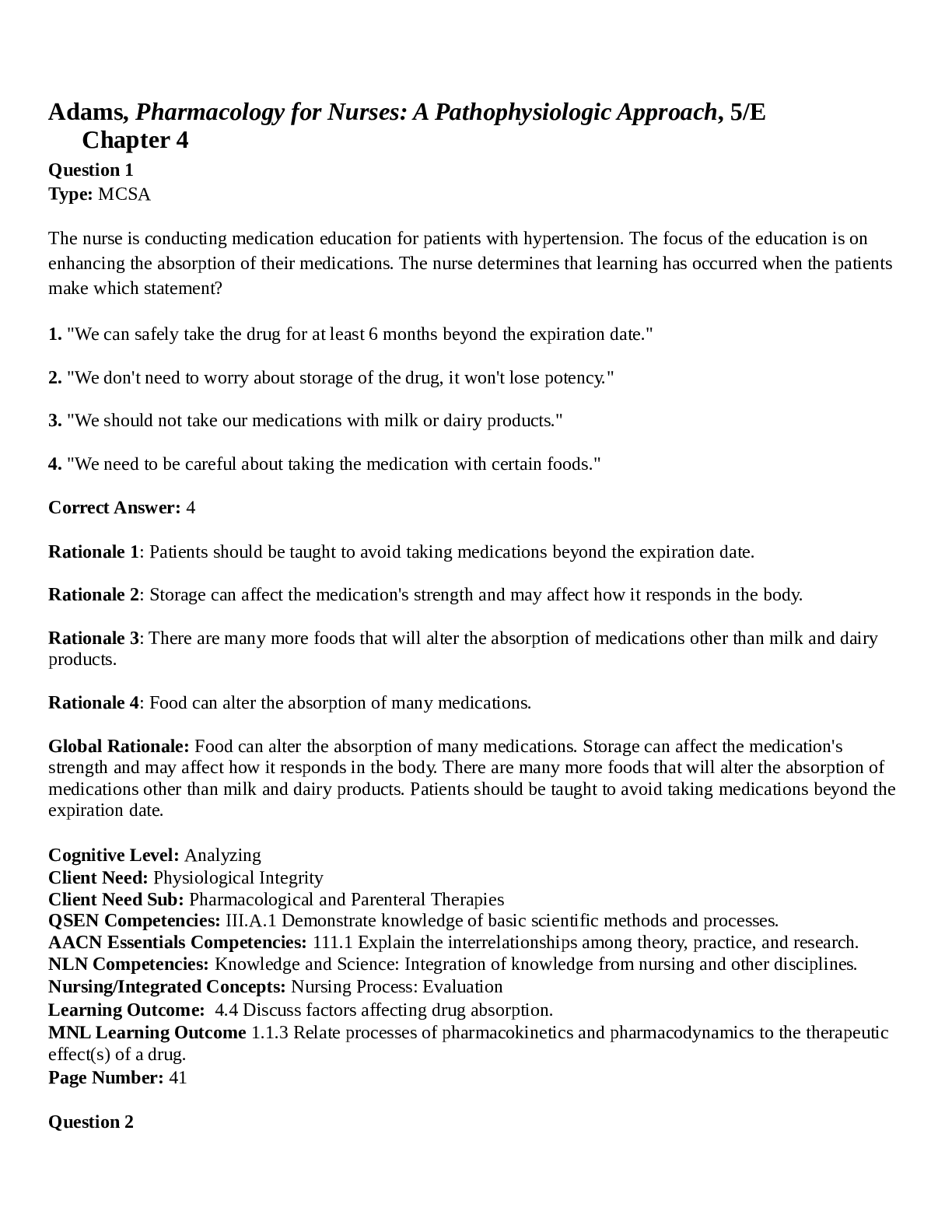
Reviews( 0 )
Document information
Connected school, study & course
About the document
Uploaded On
Nov 08, 2022
Number of pages
28
Written in
Additional information
This document has been written for:
Uploaded
Nov 08, 2022
Downloads
0
Views
301



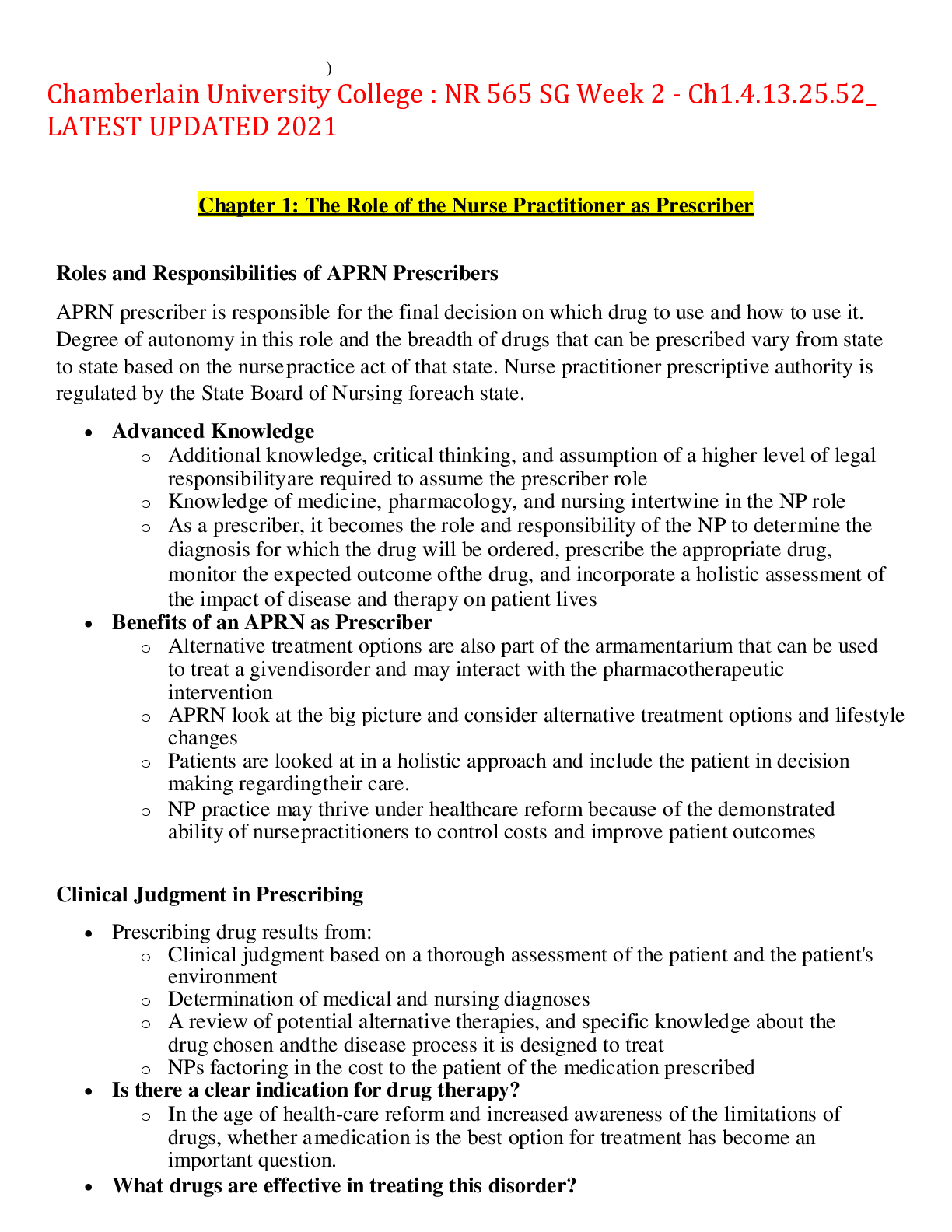
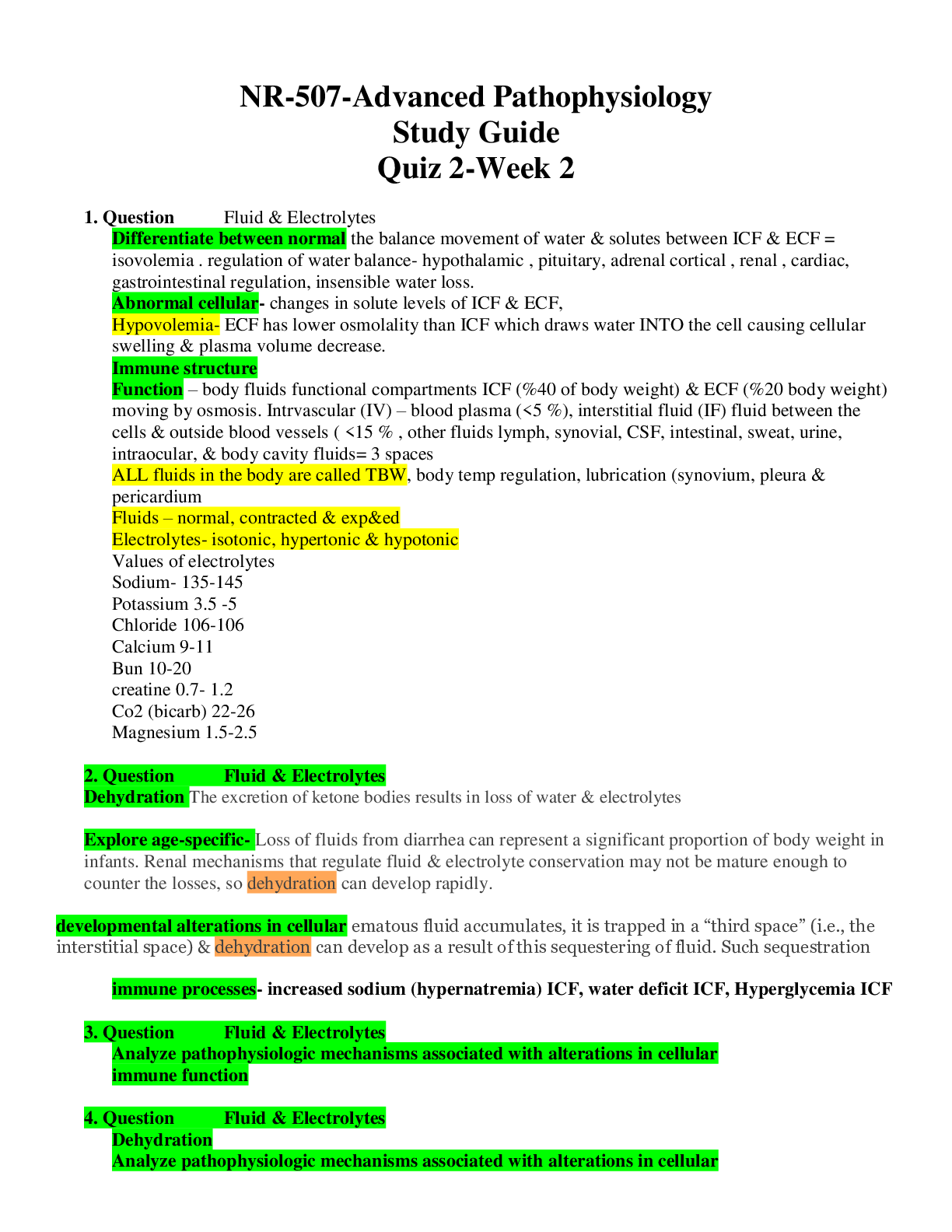
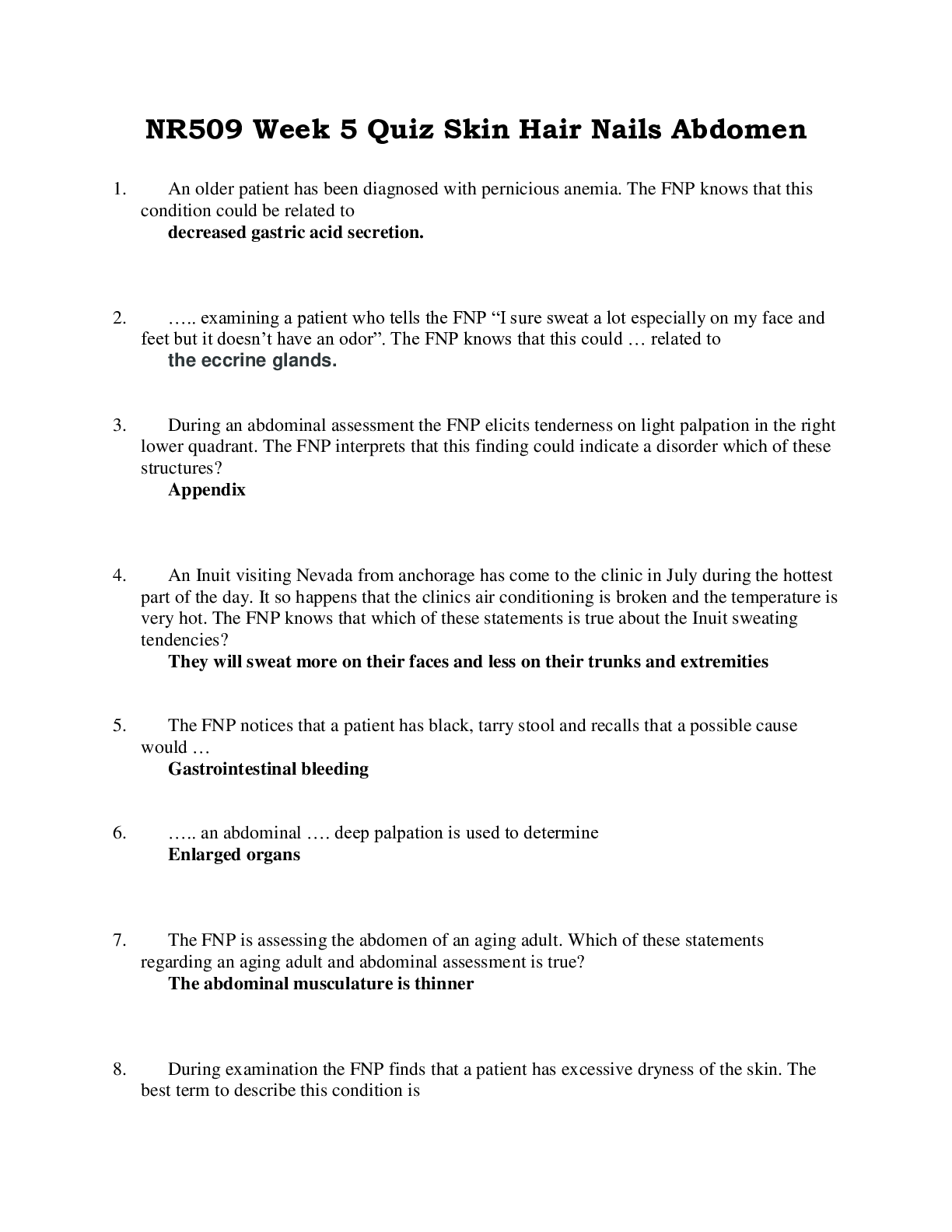
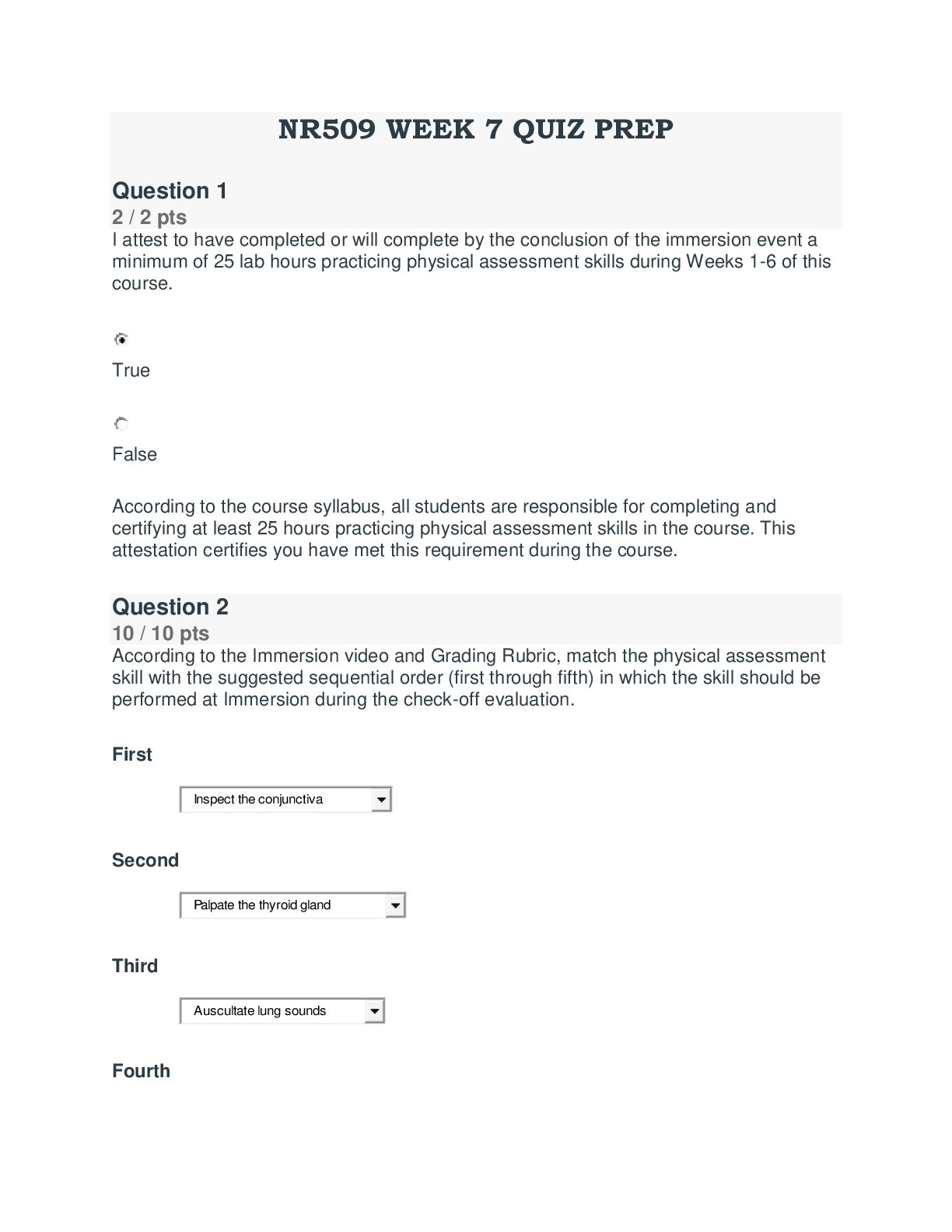
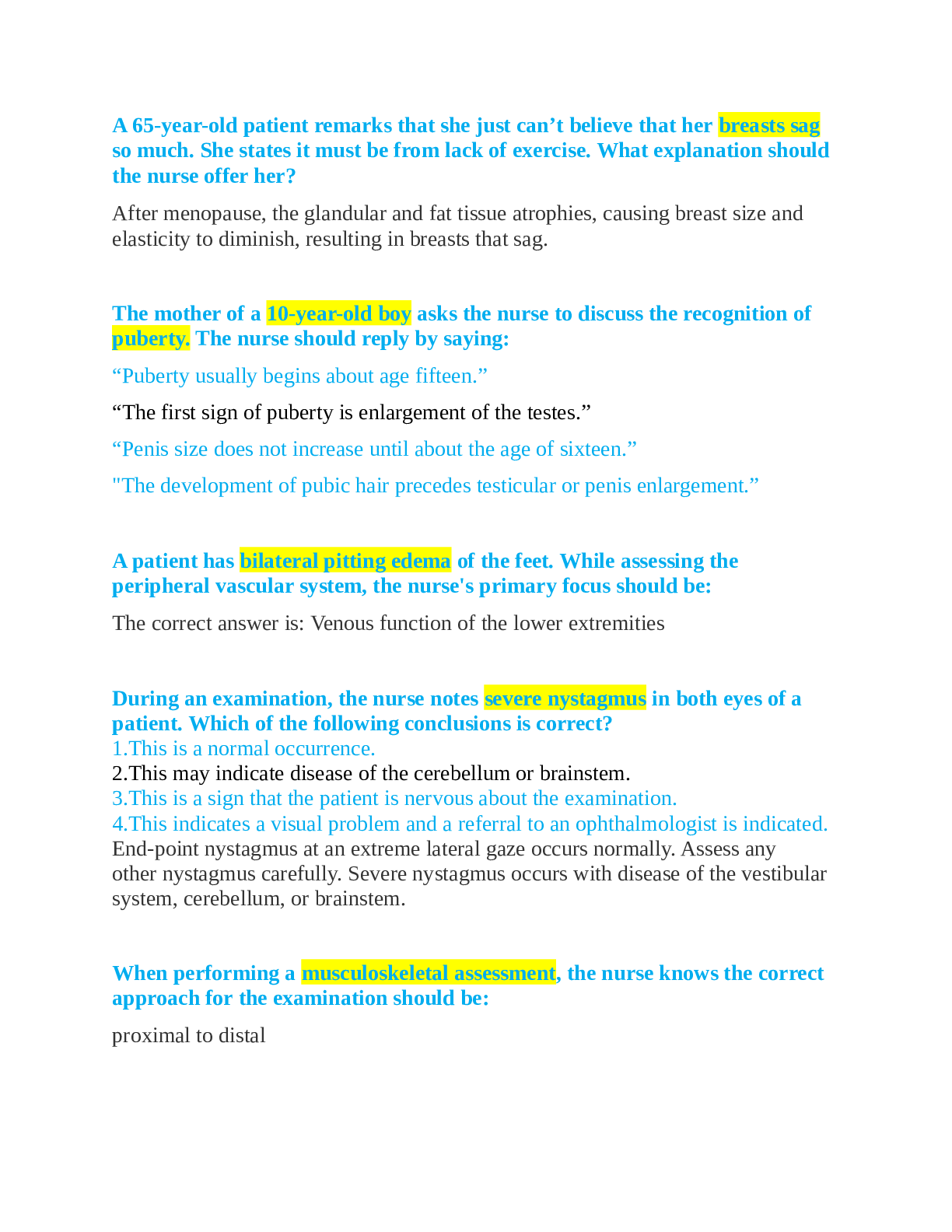

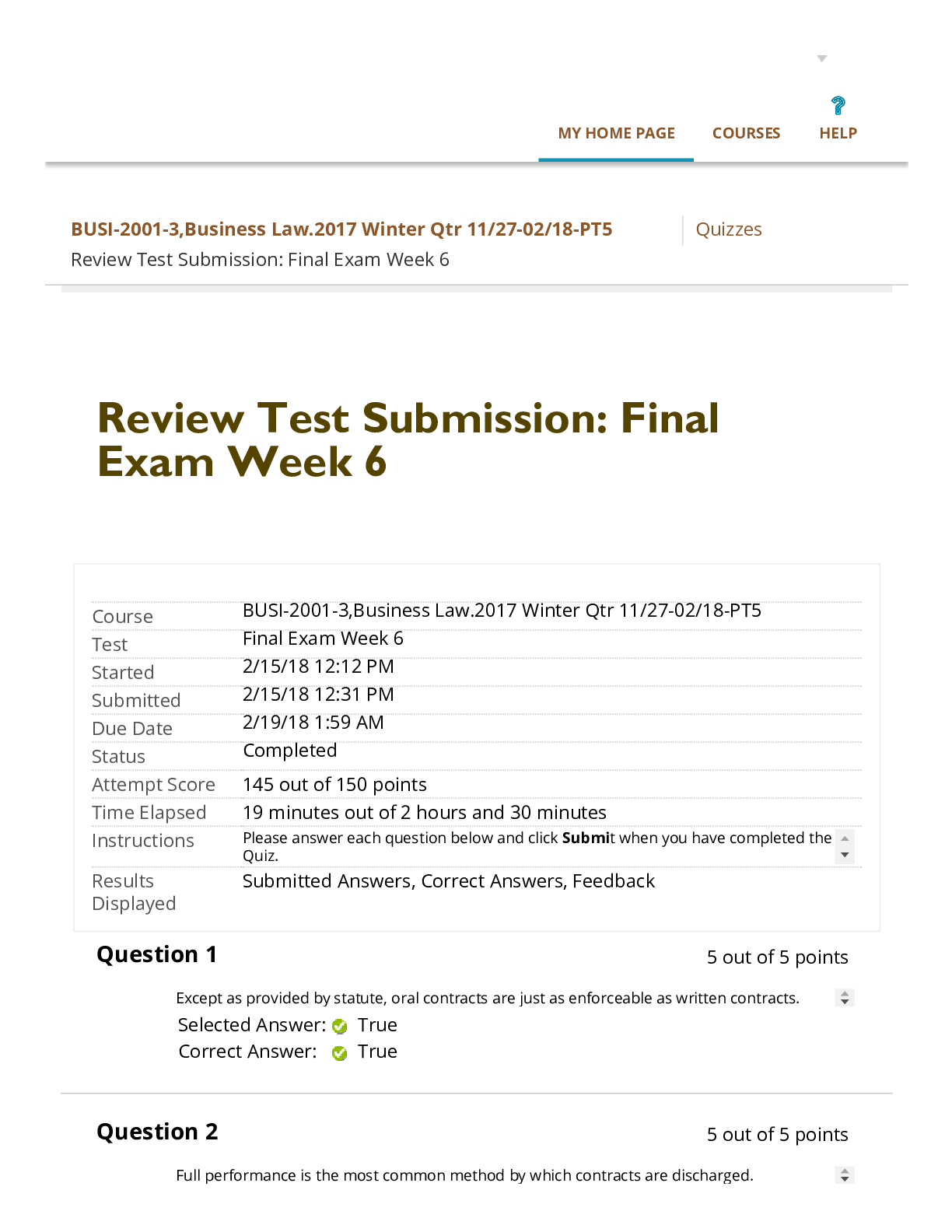

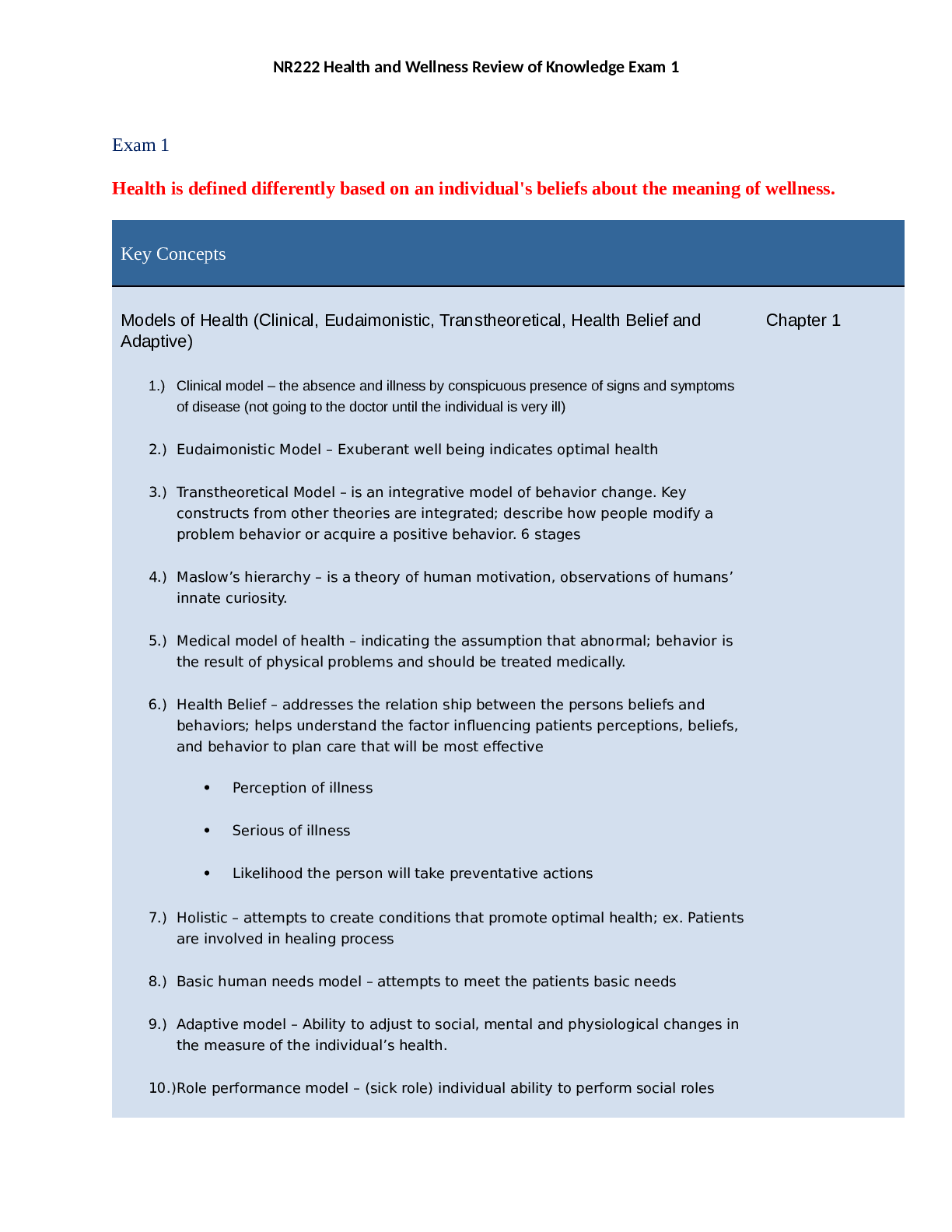
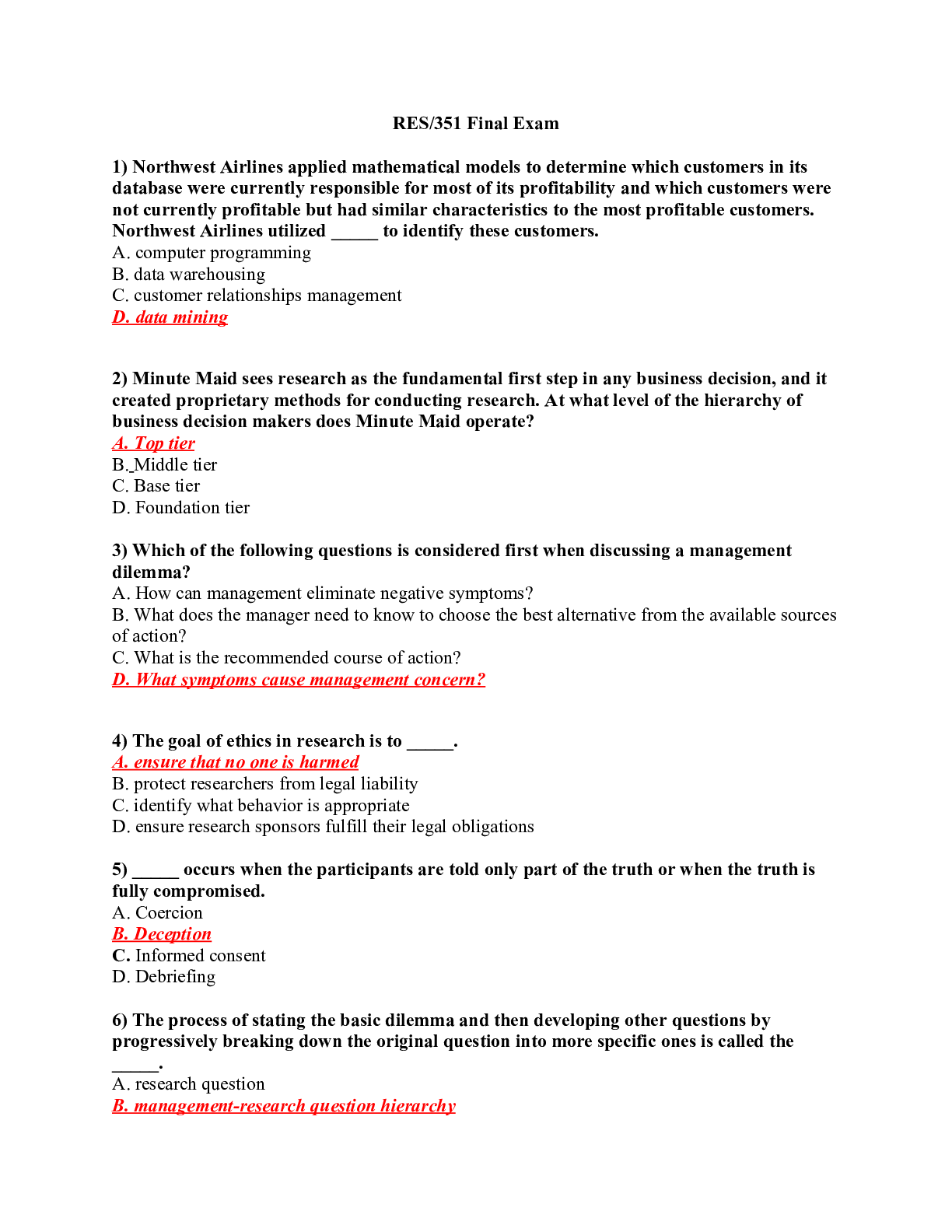
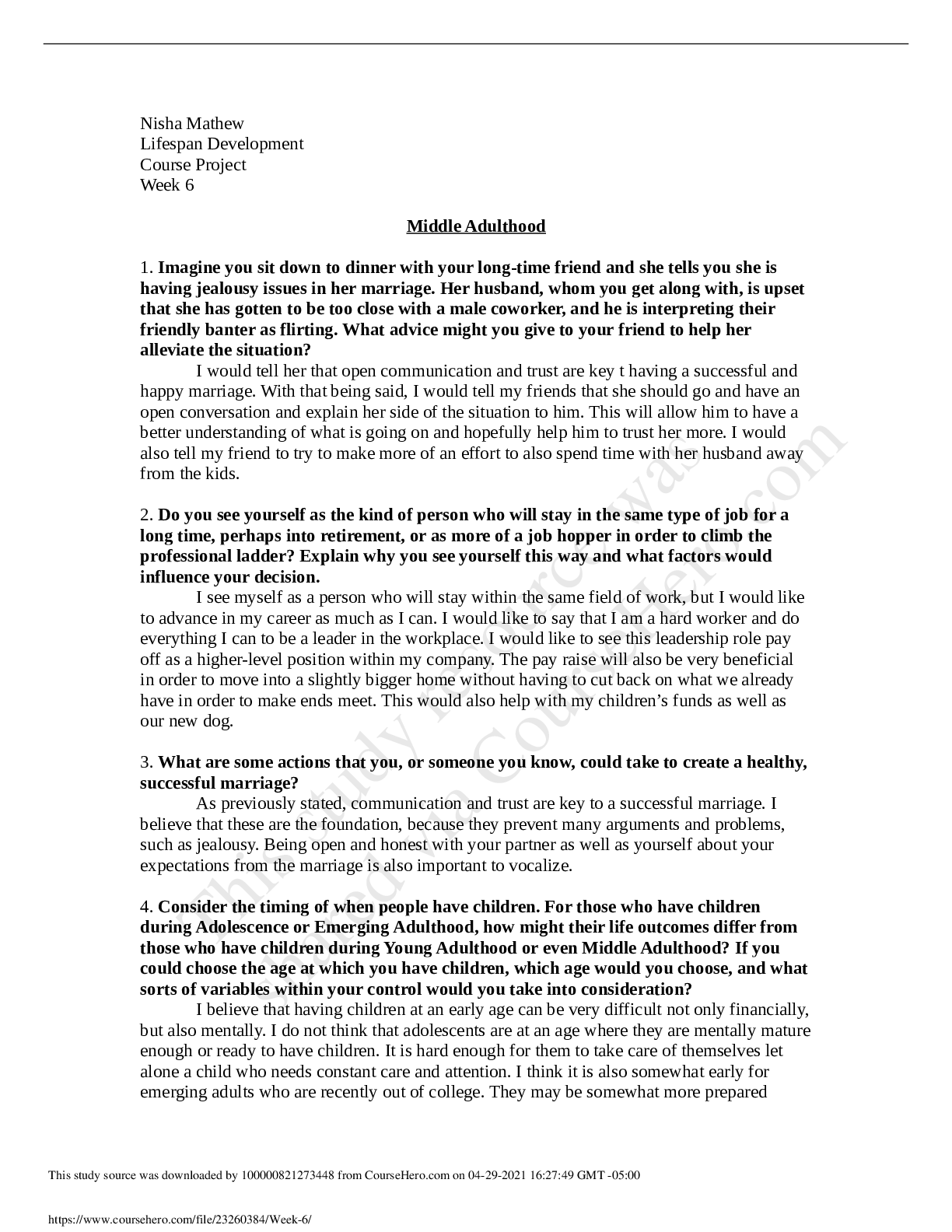

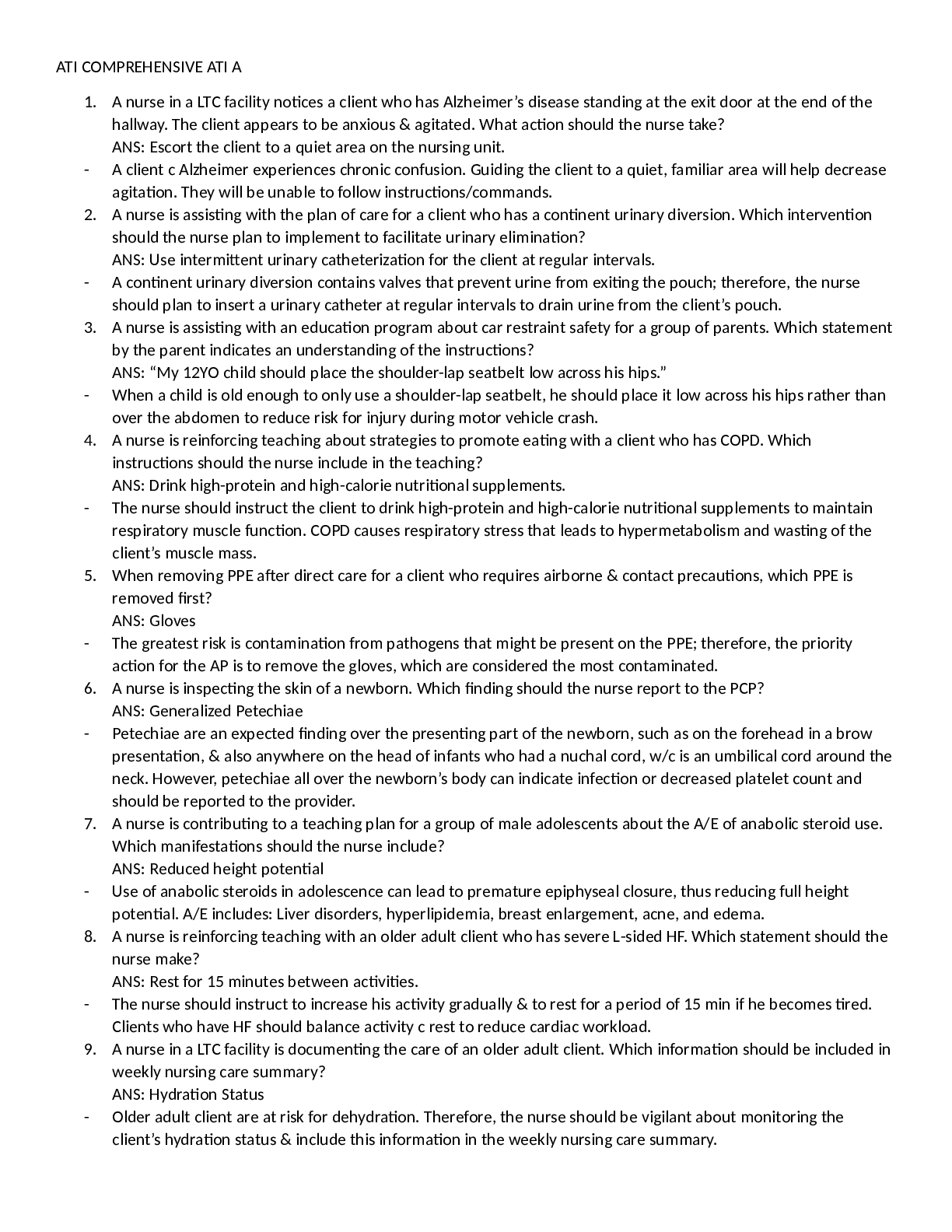

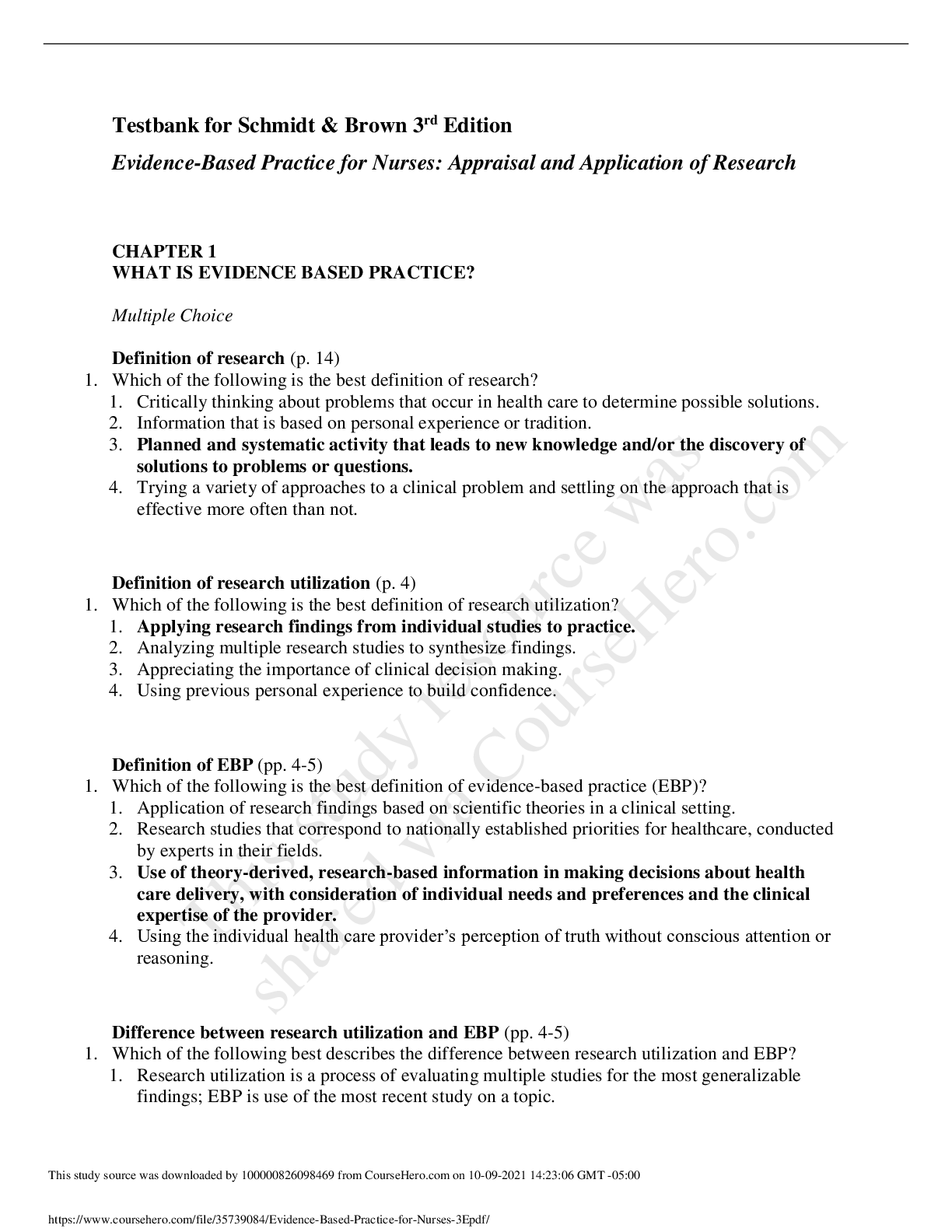
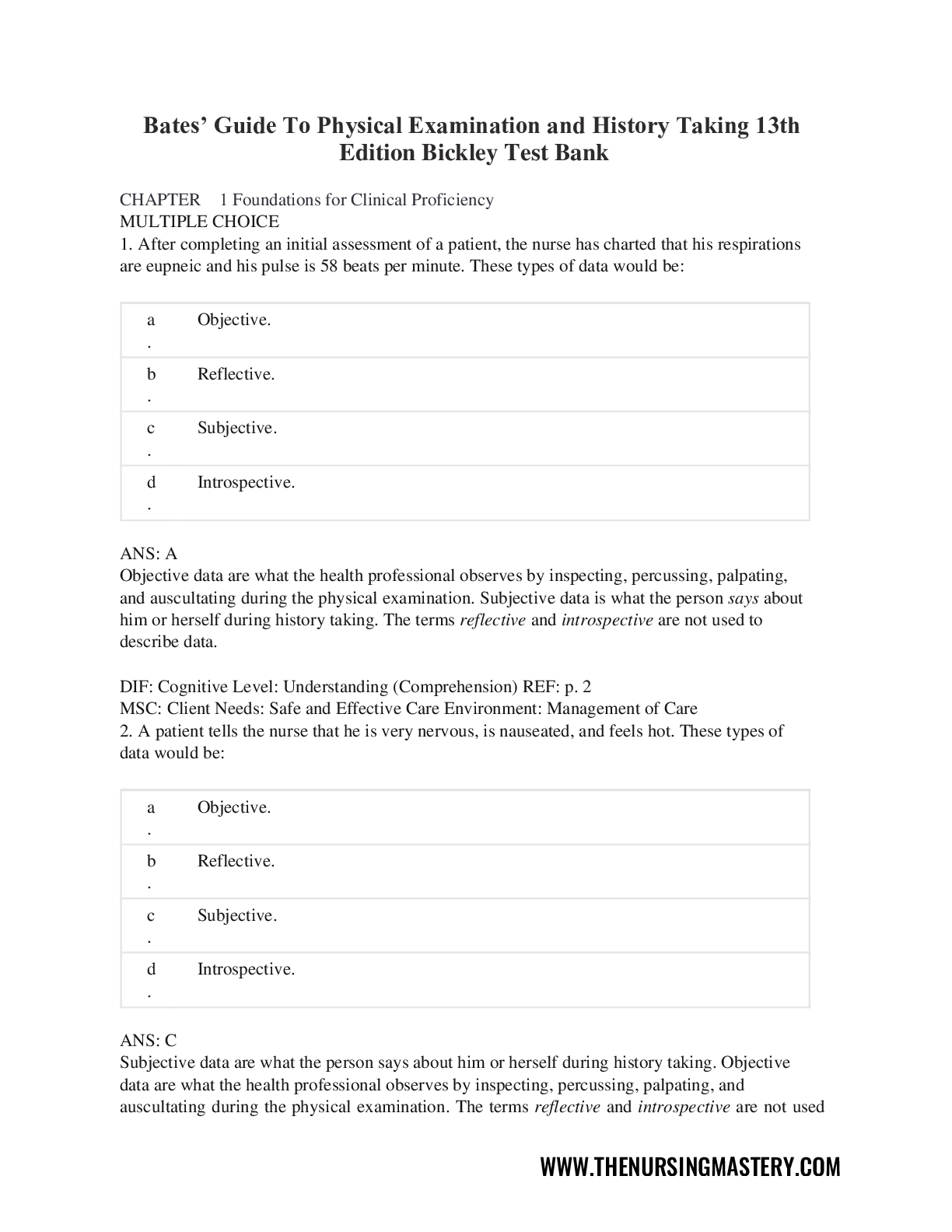
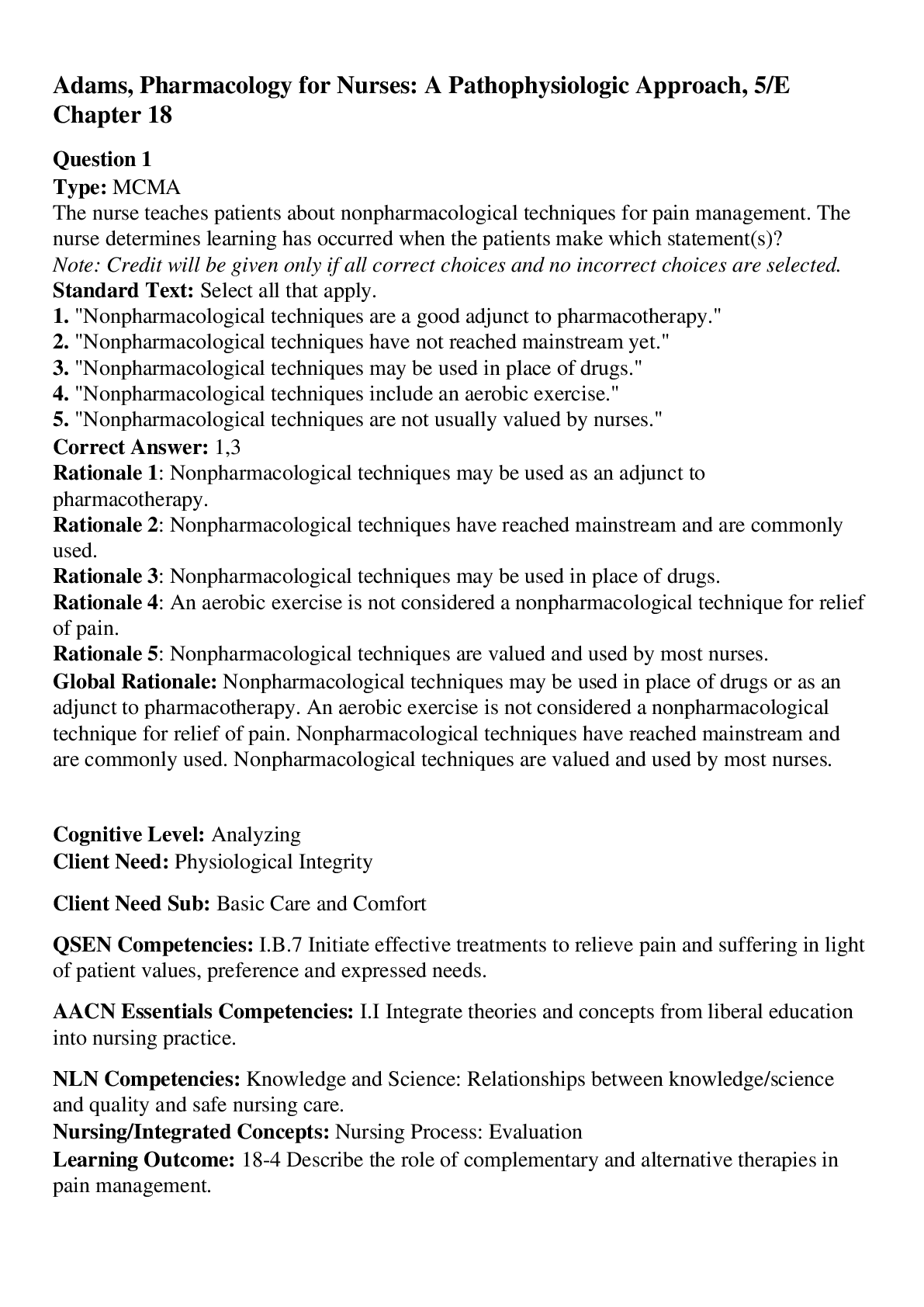
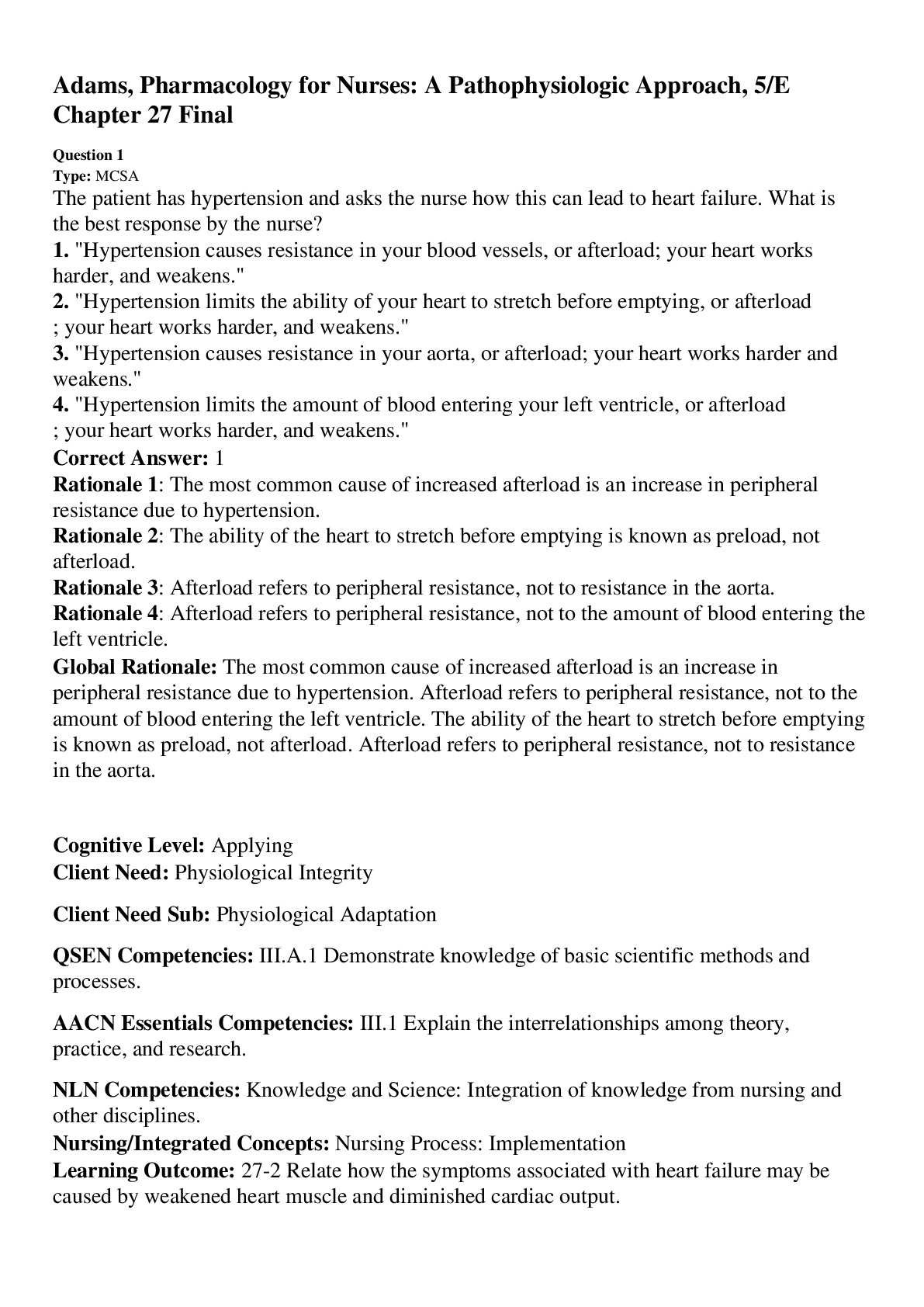


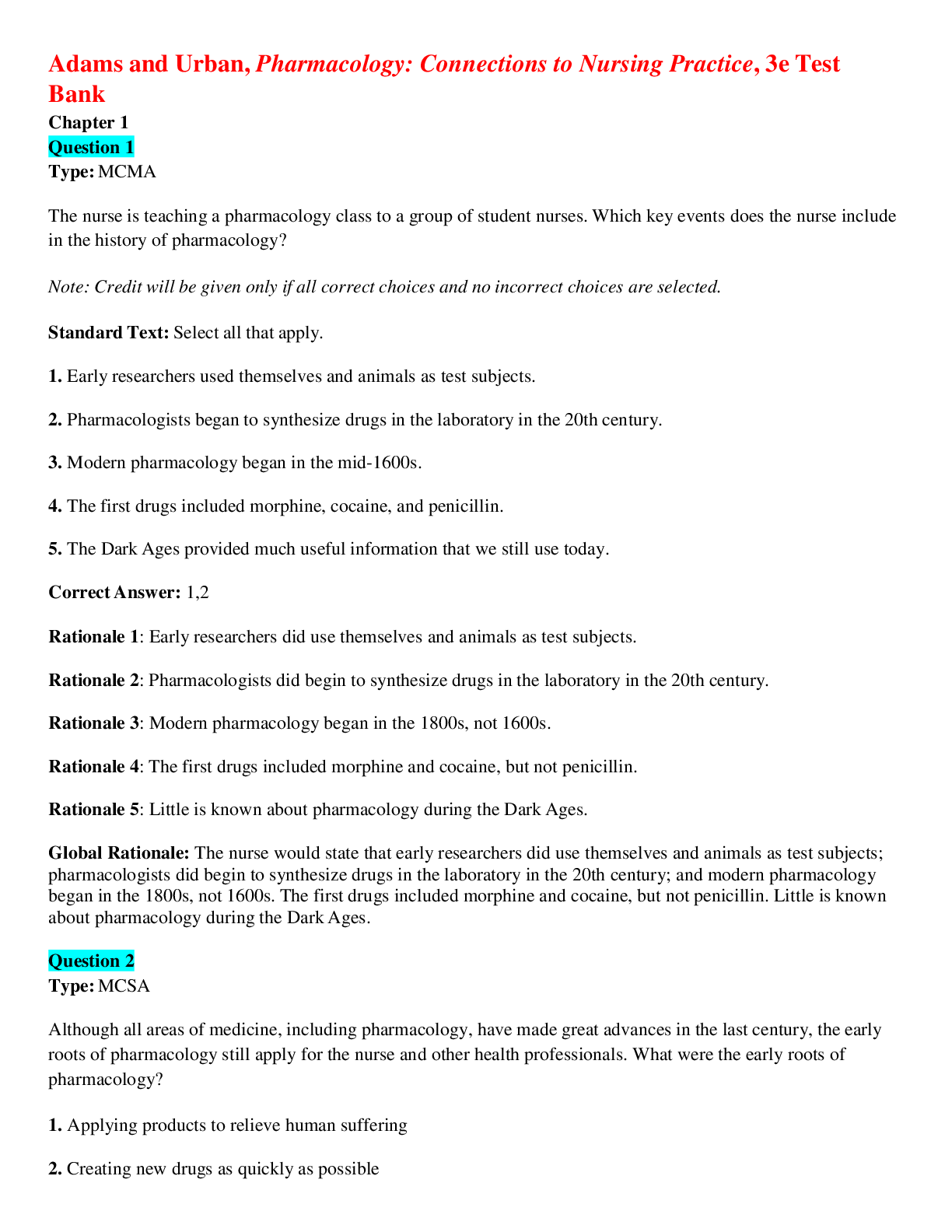


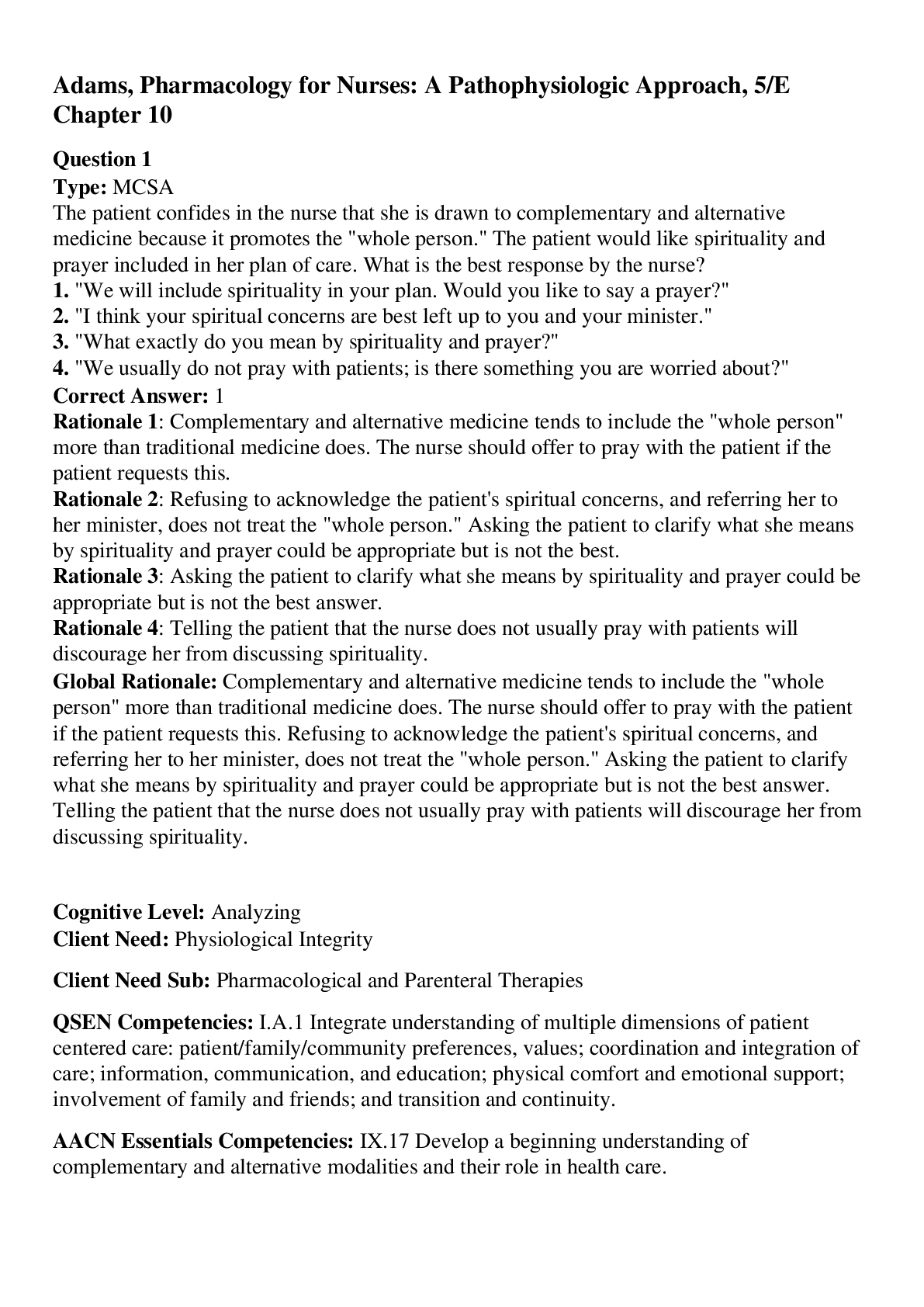
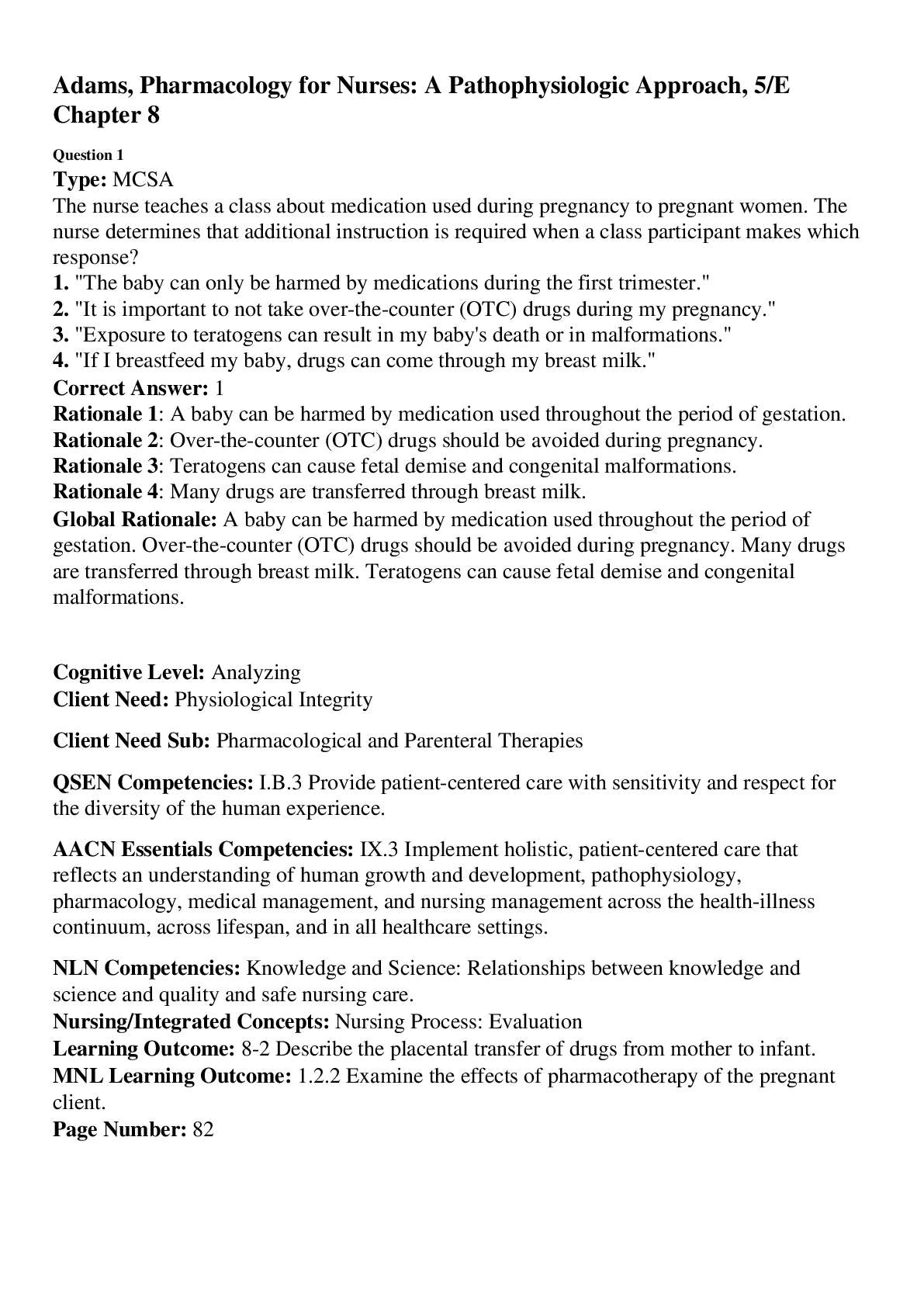
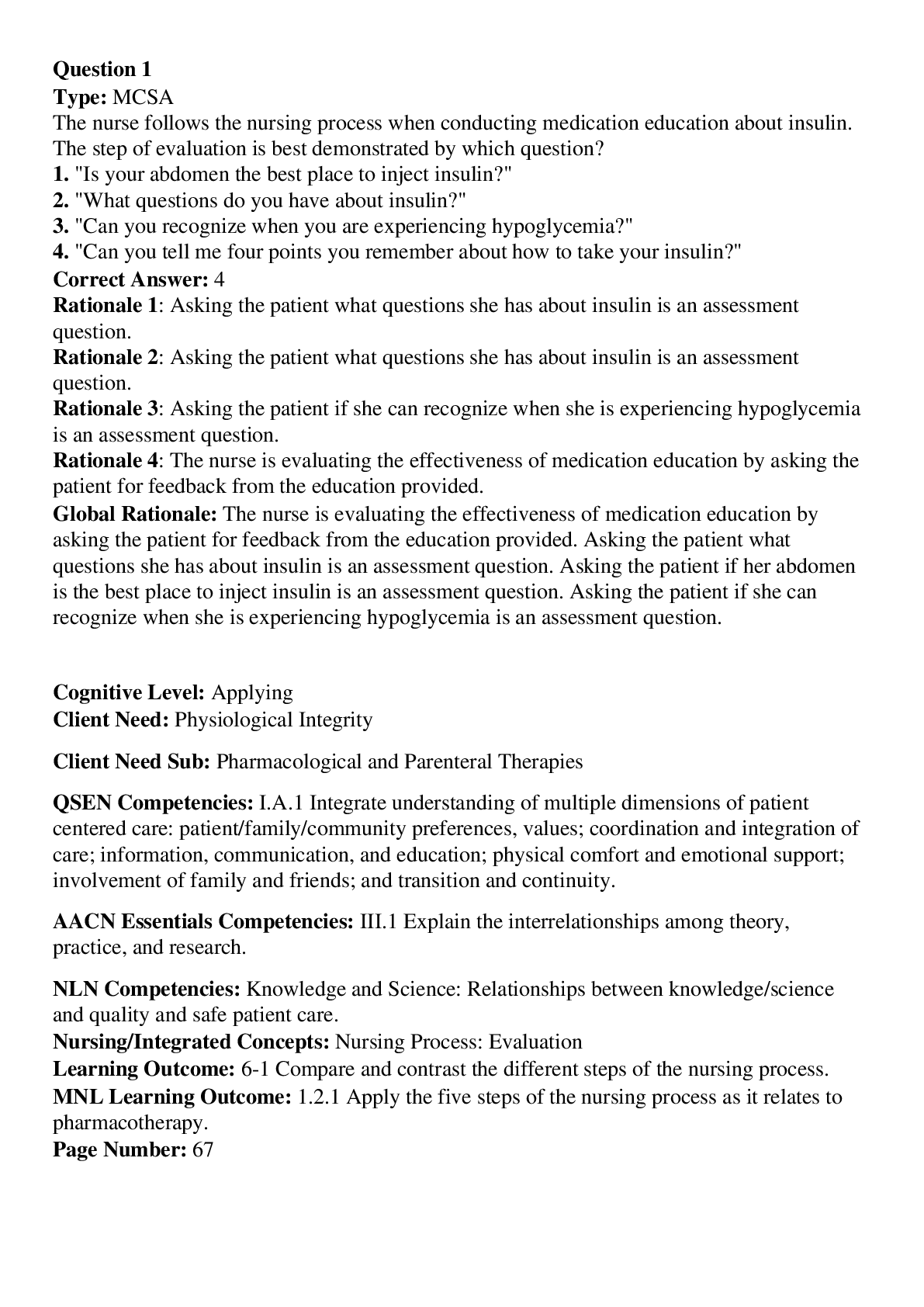
.png)

